You are here
AMSAT news
CubeSatSim Kits Available at Hamvention
For Hamvention 2024, I am very happy to announce a limited availability of Beta CubeSatSim Kits! We will have some CubeSat Simulator kits at the AMSAT booth at Hamvention on Friday and Saturday, and will also make some available online on the AMSAT Store a few weeks later – look for ANS and social media for the date they will go on sale. We will only ship AMSAT Store kit orders to U.S. addresses. They are priced at $400 including shipping.
The Beta CubeSatSim Kits contain:
- All three PCBs (STEM Payload, Solar, and Battery Boards) fully assembled and tested with all components soldered in
- Raspberry Pi Zero WH with a fully programmed micro-SD card and a fully programmed Raspberry Pi Pico WH
- AMSAT logo Remove Before Flight tag switch
- Four-piece 3D printed frame and nylon screws and nuts, ready for you to assemble with included mini screwdriver
- Pi Camera, ribbon cable, and nylon screws and nuts ready for you to plug into the Pi Zero WH and attach to the frame
- Metal standoffs, stacking headers, and JST jumpers ready for you to stack the PCBs and the Pi Zero WH into the board stack
- 10 solar panels, JST connectors, and double stick mounting tape, ready for you to solder the JST wires to the panels and mount them using the tape on the frame
- BME280 pressure, temperature, altitude, and humidity sensor, and MPU6050 IMU/gyro ready for you to solder the male pin headers so you can plug them into the sockets on the STEM Payload Board
- Two 6″ SMA coax cables and two SMA antennas for you to connect to the STEM Payload board and the frame
- Instruction sheet with parts inventory and link to the online instructions.
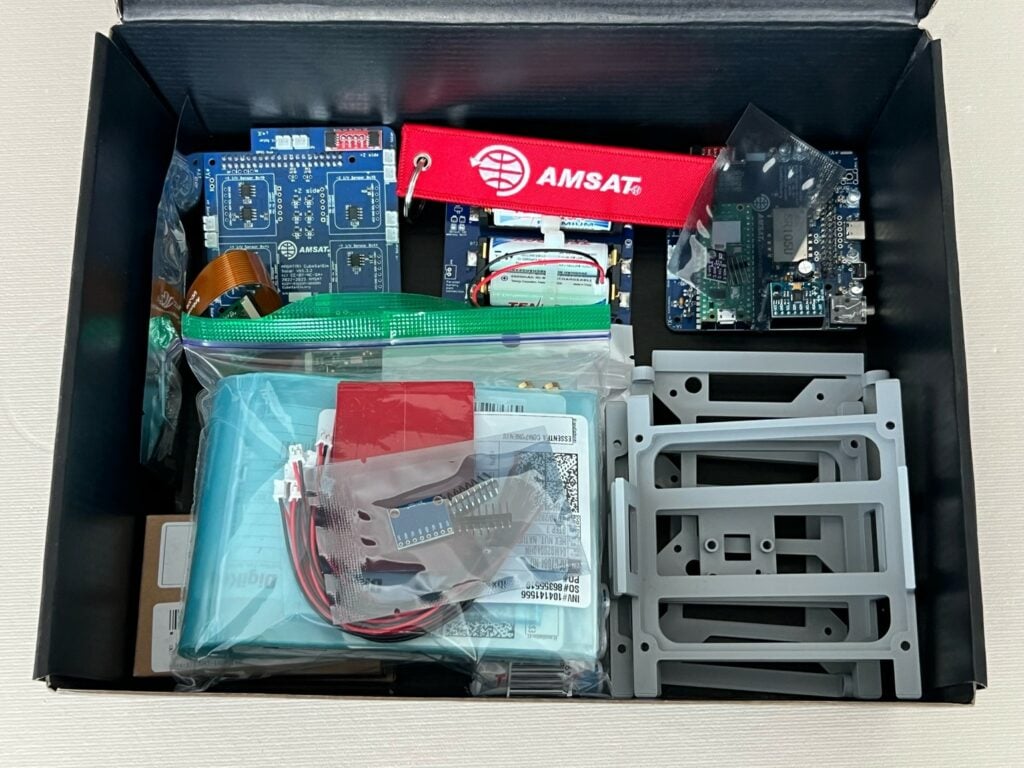 AMSAT Beta CubeSatSim Kit
AMSAT Beta CubeSatSim Kit
The approximate time for you to complete the kit by soldering the solar panels and sensor pin headers, and assembling the board stack and frame is less than two hours. You will need a soldering iron, solder, scissors, and an included mini Phillips screw driver.
The kit instructions are here: https://CubeSatSim.org/kit-beta
The current Beta CubeSatSim has some improvements over the v1.2 version, including an FM transceiver, Raspberry Pi Pico microcontroller, and RF command and control. You can also modify it to fly as a 500mW high altitude balloon payload.
You can see all the updates here: https://www.amsat.org/amsat-cubesatsim-beta-release-v1-3/
For those who like to solder the components and 3D print their own frame, we also have the Beta v1.3 blank PCB sets available at the AMSAT Store for $35: https://www.amsat.org/product/amsat-cubesatsim-pcb/ You will need to purchase the rest of the parts from Digikey and Amazon for approximately $300 using the Bill of Materials https://CubeSatSim.org/bom-beta.
During this beta period, we ask for your help in testing the new hardware and software and making sure that all the instructions and documentation are accurate. As we have announced previously, past purchasers of the CubeSatSim v1 PCB board sets are eligible for a free beta v1.3 set of PCB boards. Just email me ku2y [at] arrl.net! I will verify the order and ship you a new set of 3 blank boards. The boards will have the surface mount components already mounted. The first one hundred who contact me in the first half of this year will be eligible to receive them.
73,
Alan Johnston, PhD, KU2Y
AMSAT VP Educational Relations
ku2y [at] arrl.net
ANS-133 AMSAT News Service Weekly Bulletins
In this edition:
- 2024 AMSAT Board of Directors Election – Call for Nominations
- Last Call for AMSAT/TAPR Banquet Tickets
- Hamvention 2024 – Here We Come!
- Wanted: Your AO-7 Experiences and Memories
- AMSAT Ambassador Program Re-Introduced at Hamvention
- AMSAT Francophone & Fédération des Clubs Radioamateurs du Québec (RAQI) Publish Preliminary Geostationary Payload Proposal
- A Few Minutes with AMSAT Ambassador Clint Bradford, K6LCS
- Changes to AMSAT-NA TLE Distribution for May 10, 2024
- ARISS News
- Upcoming Satellite Operations
- Hamfests, Conventions, Maker Faires, and Other Events
- Satellite Shorts From All Over
The AMSAT News Service bulletins are a free, weekly news and information service of AMSAT, the Radio Amateur Satellite Corporation. ANS publishes news related to Amateur Radio in Space including reports on the activities of a worldwide group of Amateur Radio operators who share an active interest in designing, building, launching and communicating through analog and digital Amateur Radio satellites.
The news feed on http://www.amsat.org publishes news of Amateur Radio in Space as soon as our volunteers can post it.
Please send any amateur satellite news or reports to: ans-editor [at] amsat [dot] org.
You can sign up for free e-mail delivery of the AMSAT News Service Bulletins via the ANS List; to join this list see: https://mailman.amsat.org/postorius/lists/ans.amsat.org/
ANS-133 AMSAT News Service Weekly Bulletins
To: All RADIO AMATEURS
From: Radio Amateur Satellite Corporation
712 H Street NE, Suite 1653
Washington, DC 20002
DATE 2024 May 12
2024 AMSAT Board of Directors Election – Call for NominationsAMSAT solicits nominations for the 2024 AMSAT Board of Directors election, to be held in the third quarter of the year. The seats of the following three incumbent Directors expire in 2024 and will be filled by this year’s election:
– Mark Hammond, N8MH
– Bruce Paige, KK5DO
– Paul Stoetzer, N8HM
Further, up to two Alternate Directors may be elected for one-year terms. A valid nomination for Director must be written and requires either one Member Society or five current individual members in good standing to nominate an AMSAT member. Written nominations, with the nominee’s name, call sign, and contact information, as well as the nominators’ names, call signs, and contact information, should be sent to the AMSAT Secretary:
Jeff Davis, KE9V
PO Box 11
Yorktown, IN 47396
AMSAT bylaws require that the nomination be written and in the form specified by the Secretary who has elected to accept written nomination materials via postal mail or in electronic form, including email or electronic image of a paper document. Fax transmissions cannot be accepted.
Email nominations may be sent to jdavis [at] amsat [dot] org.
No matter what means are used, petitions MUST be received by the Secretary no later than June 15th. The Secretary will verify the qualifications of candidates and nominating members or Member Societies as petitions are received and will notify candidates whether their nominations are in order by the end of June.
[ANS thanks Jeff Davis, KE9V, AMSAT Secretary for the above information.]
Last Call for AMSAT/TAPR Banquet TicketsThe deadline for purchasing tickets for the 15th annual AMSAT/TAPR banquet is Monday, May 13th at 21:00 Z (5:00 PM EDT). Banquet tickets must be purchased in advance and will not be sold at the AMSAT booth. There will be no tickets to pick up at the AMSAT booth. Seating is limited to the number of meals sold by the deadline. Tickets purchased on-line will be maintained on a list with check-in at the door at the banquet center.
The banquet will be held at the Kohler Presidential Banquet Center on Friday, May 17th at 18:30 EDT. This dinner is always a highlight of the TAPR (Tucson Amateur Packet Radio) and AMSAT activities during the Dayton Hamvention. This year’s banquet speaker will be Bill Reed, NX5R, AMSAT PACSAT Project Manager, who will highlight the forthcoming PACSAT digital communications payload.
The Kohler Presidential Banquet Center is located at 4548 Presidential Way, Kettering, Ohio – about 20 minutes away from the Greene County Fairgrounds.
Purchase your tickets online at https://www.amsat.org/product-category/amsat-at-hamvention/
[ANS thanks Paul Stoetzer, N8HM, AMSAT Executive VP for the above information.]
The 2024 AMSAT President’s Club coins are here now!
Help Support GOLF and Fox Plus
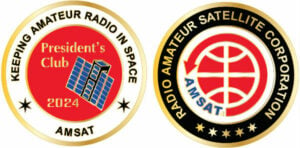
Join the AMSAT President’s Club today and help
Keep Amateur Radio in Space!
https://www.amsat.org/join-the-amsat-presidents-club/
Hamvention 2024 – Here We Come!It’s that time of the year again with only five days to go before the festivities begin.
Starting off is the annual AMSAT “Dinner at Tickets” party that will be held at Tickets Pub & Eatery on Thursday, May 16th from 6:00 PM to 8:00 PM EDT. There is no program or speaker – just good conversation. Everyone is invited regardless of whether or not they helped with setup or plan to work in the booth. Tickets has a great selection of Greek and American food and great company! Food can be ordered from the menu; drinks (beer, wine, sodas and iced tea) are available at the bar. Come as you are; no reservations required. Bring some friends and have a great time the night before Hamvention. Tickets Pub & Eatery is located at 7 W. Main St, Fairborn, OH 45324.
The 15th annual AMSAT/TAPR Banquet will be held at the Kohler Presidential Banquet Center on Friday, May 17th at 18:30 EDT. This year’s banquet speaker will be Bill Reed, NX5R, AMSAT PACSAT Project Manager, who will highlight the forthcoming PACSAT digital communications payload. Tickets must be purchased no later than Monday, May 13th 5:00 PM EDT. The Kohler Presidential Banquet Center is located at 4548 Presidential Way, Kettering, Ohio – about 20 minutes away from the Greene County Fairgrounds.
The AMSAT Forum will take place in Forum Room 2 on Saturday, May 18th at 1:20 PM – 2:50 PM. This will immediately follow the ARISS Forum in the same room at 12:10 PM, so get there early and see both presentations!
It’s not too late to volunteer for working the AMSAT booth. Whether you can lend a hand for a few hours or a full day, we can always use help. Contact Phil Smith, W1EME, AMSAT Hamvention Team Leader via email at w1eme [at] amsat [dot] org.
[ANS thanks AMSAT for the above information.]
Wanted: Your AO-7 Experiences and MemoriesAs we prepare to celebrate AO-7’s 50th anniversary since its launch on November 15, 1974, a small team of writers are collecting stories about the history of this record-breaking satellite, now the longest operating satellite of any type – government, military, commercial or private. Mr. Jan King, W3GEY/VK4GEY was a member of the original team of hams that were responsible for the design, build and launch of AO-7. Jan is interested in hearing how hams adapted to AO-7’s operating characteristics over the years. He is also especially interested in accounts of how AO-7 was used for operational or scientific experiments.
Jan continues to track and monitor the health of AO-7 after all these years. Jan predicts that within a few months AO-7 will enter a period of five years of continuous sunlit operation without eclipse interruptions. Already with 50 years behind it, AO-7 might continue to set new records and host more invaluable scientific studies and practical uses.
Working with Jan is Frank Karnauskas, N1UW, AMSAT VP-Development. Amateurs with stories they wish to contribute to the project are encouraged to contact Frank via email f.karnauskas [at] amsat [dot] org.
[ANS thanks Jan King, W3GEY/VK4GEY and Frank Karnauskas, N1UW, AMSAT VP-Development for the above information.]
Need new satellite antennas?
Purchase M2 LEO-Packs from the AMSAT Store.

When you purchase through AMSAT, a portion of the proceeds goes towards
Keeping Amateur Radio in Space.
https://amsat.org/product-category/hardware/
AMSAT Ambassador Program Re-Introduced at HamventionSometimes in the past referred to as Field Operations, other times as Area Coordinators, maintaining a presence at local hamfests and at ARRL conventions has been a long standing AMSAT tradition. Now known as the AMSAT Ambassador Program, our volunteers continue this important activity, stimulating interest in amateur satellites, helping newcomers get on the air and building membership in AMSAT.
At this year’s Hamvention, AMSAT is pleased to introduce Mr. Bo Lowrey, W4FCL, Director – AMSAT Ambassador Program. Bo has a solid background in aerospace education and public relations including serving as Director – Space Science and IT for the National Air and Space Education Institute in Louisville, KY and as a NASA / JPL Solar System Ambassador Applicant Review, Jet Propulsion Laboratory in Pasadena, CA.
Under Bo’s leadership, the Ambassador Program is being revitalized with new levels of support for volunteers. This included new display banners and presentation folders for local hamfests as well as a special callsign badge and a selection of Ambassador branded apparel. A fresh set of updated PowerPoint scripted presentations are also being made available for in-person and online club presentations.
Training will also be made available to help prepare volunteers for making the best possible presence to their audiences. Volunteers will also have access to online technology such as Microsoft Teams to collaborate with fellow Ambassador volunteers.
While in past years, AMSAT’s presence at local hamfests was largely up to volunteers in the area, Bo plans to be more pro-active in recruiting volunteers to be available for major events such as ARRL Section and Division conventions as well as at major events hosted by special interest groups such as VHF/UHF and microwave societies.
AMSAT members who are interested in more information on becoming an AMSAT Ambassador are encouraged to visit the AMSAT booth at Hamvention and meet with Bo. If you are not attending Hamvention, please contact Bo via email blowrey [at] amsat [dot] org.
[ANS thanks Bo Lowrey, W4FCL, Director – AMSAT Ambassador Program for the above information.]
AMSAT Francophone & Fédération des Clubs Radioamateurs du Québec (RAQI) Publish Preliminary Geostationary Payload ProposalAMSAT Francophone (AMSAT-F) and Fédération des clubs radioamateurs du Québec (RAQI) are soliciting comments on their draft proposal to the European Space Agency (ESA) for an amateur geostationary payload. AMSAT-UK, the British Amateur Television Club (BATC), and AMSAT-NA, with input from the UK Microwave Group, previously submitted a proposal (https://www.amsat.org/wordpress/wp-content/uploads/2023/12/ESA-GEO-proposal-AMSAT-UK.pdf) as has AMSAT-DL (https://amsat-dl.org/en/the-next-generation-of-a-geo-meo-amateur-radio-payload/).
These proposals have been submitted in response to an ESA call for proposals for a future amateur geostationary payload with the potential to cover Europe and at least a portion of North America.
The English version of the proposal can be found at https://site.amsat-f.org/download/119824/?tmstv=1715353379 and the French version can be found at https://site.amsat-f.org/download/119821/?tmstv=1715353379.
Comments may be submitted to groupe.travail.geo.esa [at] amsat-f [dot] org by May 24, 2024.
[ANS thanks AMSAT-F for the above information.]
Want to fly the colors on your own grid expedition?
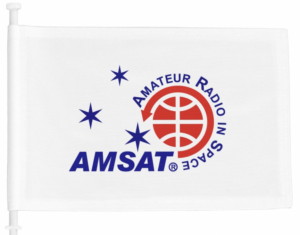
Get your AMSAT car flag and other neat stuff from our Zazzle store!
25% of the purchase price of each product goes towards
Keeping Amateur Radio in Space
https://www.zazzle.com/amsat_gear
A Few Minutes with AMSAT Ambassador Clint Bradford, K6LCSANS writer Mark Blackwood, KI5AXK, was able to catch AMSAT Ambassador Clint Bradford, K6LCS in between one of his popular club presentations. As of this writing, Clint has presented his introduction to amateur satellites and the AMSAT story over 170 times.
ANS: How did you get started in amateur satellites?
CLINT: “Mark, it was about 18 years ago that I saw an AMSAT display table at a local ham convention. I initially just passed it by, mistakenly thinking a ham required 100 watts of transmit power, that expensive Yaesu rotator, and dual Yagi antennas on the roof. But, when I was told hams were “working some birds” with low power and handheld stations, well, that’s when I started to search the net for information.
“But, there’s a problem. If one Google searches “work amateur satellites”, either today or 18 years ago, up pops old information on some satellites that were easy to access, but whose service ended years before. I had a Boy Scout Scoutmaster call me about five years ago. He was disappointed and irritated. He had an assemblage of 300 Scouts, parents, and community members in an auditorium and was all set up to demonstrate satellite comms via AO-51. He searched for “work amateur satellites” and found info for it, but AO-51’s lifespan was from 2004 to 2011.
“So I preface my satellite presentations with a disclaimer: “Folks, what I am going to tell you today about, specific satellites, just might not be accurate next week. We may gain a bird, we may lose a bird. The ISS’ gear may be up and running tonight but it gets turned off when there is a spacewalk and/or when there is a mission heading towards or away from it. Stick with amsat.org, amsat-uk.org, ariss.org or work-sat.com for current information. And, get to know some of the satellites’ official social media accounts.”
ANS: Which do you enjoy more, introducing satellite ham radio to newcomers, or seasoned amateur radio folks?
CLINT: “Just recently had this discussion with ARRL Orange Section Manager Bob Turner, W6RHK. Youth is our future. And it is always exciting to speak and demo at elementary, middle, and high school campuses. But, ham clubs have varied audiences, too. And by using Zoom, I have been able to speak to clubs not only in Southern CA, but also across the US, to Canada, and to Europe. Zoom sessions enable anyone with a smartphone or home computer to attend a session – folks without transportation, those who don’t drive, those who may be ill at the time. At the end of each presentation, I ask for a show of hands, ‘Now that you’ve seen how easy this can be, is anyone thinking of going outside and maybe just listening for the FM voice repeater on the ISS for their first time?’ The satisfaction comes when a couple hands rise!”
ANS: What is the most difficult thing for people getting started?
CLINT: “Possibly the same problems I had, Mark, almost 20 years ago: mic fright and thinking I had insufficient equipment. As I walk my presentations’ attendees through the timer on the SO-50 satellite that might need to be activated, I see jaws drop. ‘Yes, you become the control operator of an orbiting satellite!’ I also tell them how tentative I was doing that my first time, “Gawd, if I mess up, SO-50’s going to crash into my Koi pond – the AMSAT handcuffs might be too tight!
I also include audio of my 2 meter contact with ISS Commander, Reid Wiseman. There I am – using a non-full-duplex HT that is turned down to 2 watts transmit power, speaking to an ISS astronaut who was about 450 miles downrange when we began. That really shows my show attendees that elaborate, expensive station setups are not mandatory! And, it demonstrates “line-of-sight!”
ANS: What do people enjoy the most about amateur satellite radio?
CLINT: “I have given my presentation 174 times. Never the same exact show to anyone as each is customized to their club or event. Using a non-cookie-cutter slide show gets folks more interested in what’s coming up. I couple step-by-step instructions with a single, large image per slide. And my mantra, ‘You do not need 100 watts – you do not need expensive equipment.’ Clubs continue to request my ‘Getting Started’ presentation and tell me afterwards that they enjoyed themselves.
“I’m still finding audiences, well, they find me, who haven’t been exposed to the easy-to-work FM voice satellites. So, getting them to know they don’t need a lot of stuff to successfully make contacts seems to turn a lot on to this aspect of our hobby.”
ANS: What types of groups or people do you usually talk to?
CLINT: “The vast majority have been individual amateur radio clubs. I spoke to an astronomy club last month – not a whole lot of hams, but we found plenty of cross interests to have a great time. I have also spoken at several ham conventions. And I was honored to orchestrate one of those contacts between a classroom of students and an astronaut aboard the ISS. These ARISS contacts are a year’s worth of preparation for a 15-minute conversation – but, oh, what a conversation!”
[ANS thanks Clint Bradford, K6LCS, AMSAT Ambassador and Mark Blackwood, KI5AXK, ANS writer for the above information.]
Changes to AMSAT-NA TLE Distribution for May 10, 2024Two Line Elements or TLEs, often referred to as Keplerian elements or keps in the amateur community, are the inputs to the SGP4 standard mathematical model of spacecraft orbits used by most amateur tracking programs. Weekly updates are completely adequate for most amateur satellites. TLE bulletin files are updated daily in the first hour of the UTC day. New bulletin files will be posted immediately after reliable elements become available for new amateur satellites. More information may be found at https://www.amsat.org/keplerian-elements-resources/.
The following satellite has been removed from this week’s AMSAT-NA TLE distribution:
Changshagaoxin NORAD Cat ID 43669 Decayed from orbit on or about 09 May 2024
[ANS thanks Joe Fitzgerald, KM1P, AMSAT Orbital Elements Manager, for the above information.]
ARISS NEWSAmateurs and others around the world may listen in on contacts between amateurs operating in schools and allowing students to interact with astronauts and cosmonauts aboard the International Space Station. The downlink frequency on which to listen is 145.800 MHz worldwide.
- Completed Contacts
Wireless Institute of Australia/Bundaberg High School Amateur Radio Club, Bundaberg, Queensland, Australia, telebridge via VK6MJ
The ISS callsign was NA1SS.
The crewmember is Mike Barratt, KD5MIJ.
The ARISS mentor was Shane Lynd, VK4KHZ
Contact was successful on Saturday May 5, 2024.
The crossband repeater continues to be active (145.990 MHz up {PL 67} & 437.800 MHz down). If any crewmember is so inclined, all they have to do is pick up the microphone, raise the volume up, and talk on the crossband repeater. So give a listen, you just never know.
The packet system is also active (145.825 MHz up & down).
As always, if there is an EVA, a docking, or an undocking; the ARISS radios are turned off as part of the safety protocol.
Note, all times are approximate. It is recommended that you do your own orbital prediction or start listening about 10 minutes before the listed time.
The latest information on the operation mode can be found at https://www.ariss.org/current-status-of-iss-stations.html.
The latest list of frequencies in use can be found at https://www.ariss.org/contact-the-iss.html.
[ANS thanks Charlie Sufana, AJ9N, one of the ARISS operation team mentors for the above information.]
Upcoming Satellite OperationsNo operations listed.
A growing number of satellite rovers are currently engaged in sharing their grid square activations on https://hams.at. By visiting the website, you gain easy access to comprehensive information about the operators responsible for activating specific grid squares. Additionally, you have the ability to assess the match score between yourself and a particular rover for a given pass, while also being able to identify the upcoming satellite passes that are accessible from your location.
[ANS thanks Ian Parsons, K5ZM, AMSAT Rover Page Manager, and Alex Ners, K6VHF, for the above information.]
Hamfests, Conventions, Maker Faires, and Other EventsAMSAT Ambassadors provide presentations, demonstrate communicating through amateur satellites, and host information tables at club meetings, hamfests, conventions, maker faires, and other events.
AMSAT Ambassador Clint Bradford, K6LCS, says, “Think a 75-minute presentation on “working the easy satellites” would be appropriate for your club or event? Let me know by emailing me at k6lcsclint (at) gmail (dot) com or calling me at 909-999-SATS (7287)!”
AMSAT Dinner at Tickets
Thursday, May 16, 2024
6:00 PM to 8:00 PM EDT
7 W. Main St, Fairborn, OH 45324
Dayton Hamvention 2024
Friday May 17 – Sunday May 19, 2024
Greene County Fairgrounds and Expo Center
120 Fairground Road
Xenia, OH 45385
https://hamvention.org
[ANS thanks the AMSAT Events page for the above information.]
Satellite Shorts From All OverSince April 28, 2019, the Swiss satellite net on QO-100 has been a consistent weekly event, marking its fifth anniversary on the same date in 2024. Hosted by HB9RYZ initially and later by HB9TSI from Italy, the round convenes every Sunday at 9:00 p.m. on 10489.740 MHz, typically with 5 to 10 participants, though 15 joined for the anniversary round. Led by Paul, HB9DFQ, the round maintains a familiar format: participants check in, share station updates and radio experiences, delve into topics, and bid farewell. Despite no specific celebration planned, the anniversary drew a hearty attendance. Notable moments include Roman, HB9HCF’s reports from Antarctica during the pandemic, while regular attendees like IS0/HB9SJP and supportive listeners add to the camaraderie. The inaugural round was preserved on Soundcloud by HB9WDF, encapsulating the enduring spirit of this community gathering. More information at https://www.amsat-hb.org/willkommen?b=1000278&c=ND1000105&s=03. [ANS thanks AMSAT-BB for the above information for the above information.]
In May, there are two planned attempts to establish contacts from Newfoundland using the QO-100 geostationary satellite amateur transponders, despite Newfoundland being just outside the satellite’s coverage area. With the elevation at Signal Hill in St. Johns being -0.9°, there’s optimism due to successful contacts made from Indonesia at an elevation as low as -1.3°. Gopan VO1/M0XUU (VU3HPF) will be in Newfoundland from May 8-15 for the initial attempt, while David VO1/G0MRF and Graham VO1/G3VZV will be there from May 15-19, planning to utilize various modes including SSB, CW, FT8, FT4, and DATV. Updates on their progress can be found on their respective online platforms, and additional information on making QO-100 contacts is available via a presentation by Graham G3VZV and on the AMSAT-DL forum. More information at https://amsat-uk.org/2024/05/05/newfoundland-on-qo-100/. [ANS thanks AMSAT-UK, for the above information.]
Join AMSAT today at https://launch.amsat.org/
In addition to regular membership, AMSAT offers membership to:
- Societies (a recognized group, clubs or organization).
- Primary and secondary school students are eligible for membership at one-half the standard yearly rate.
- Post-secondary school students enrolled in at least half time status shall be eligible for the student rate for a maximum of 6 post-secondary years in this status.
- Memberships are available for annual and lifetime terms.
Contact info [at] amsat [dot] org for additional membership information.
73 and remember to help Keep Amateur Radio in Space!
This week’s ANS Editor, Frank Karnauskas, N1UW
n1uw [at] amsat [dot] org
ANS-126 AMSAT News Service Weekly Bulletins
In this edition:
* Greencube Terminal Program: Version 1.0.0.90 Enhancements and Updates
* Chang’e-6 Successfully Launches: China’s Historic Lunar Mission Begins
* NASA Reveals SpaceX’s Innovative Plan for Starship Refueling in Orbit
* GridMasterMap Satellite Top 100 Rovers May 2024 Rankings
* Changes to AMSAT-NA TLE Distribution for May 3, 2024
* ARISS News
* Upcoming Satellite Operations
* Hamfests, Conventions, Maker Faires, and Other Events
* Satellite Shorts From All Over
The AMSAT News Service bulletins are a free, weekly news and information service of AMSAT, the Radio Amateur Satellite Corporation. ANS publishes news related to Amateur Radio in Space including reports on the activities of a worldwide group of Amateur Radio operators who share an active interest in designing, building, launching and communicating through analog and digital Amateur Radio satellites.
The news feed on https://www.amsat.org publishes news of Amateur Radio in Space as soon as our volunteers can post it.
Please send any amateur satellite news or reports to: ans-editor [at] amsat.org
You can sign up for free e-mail delivery of the AMSAT News Service Bulletins via the ANS List; to join this list see: https://mailman.amsat.org/postorius/lists/ans.amsat.org/
ANS-126 AMSAT News Service Weekly Bulletins
To: All RADIO AMATEURS
From: Radio Amateur Satellite Corporation
712 H Street NE, Suite 1653
Washington, DC 20002
DATE 2024 May 05
Greencube Terminal Program: Version 1.0.0.90 Enhancements and UpdatesThe Greencube Terminal Program, developed by Carsten Groen, OZ9AAR, has taken another leap forward in its evolution with the launch of Version 1.0.0.90. This latest update brings a number of enhancements and fixes geared towards bolstering operational efficiency and enriching the user experience, particularly for IO-117 satellite enthusiasts.
One of the standout features of this update is the integration of UHM 2.1 (yoU Heard Me), supplanting the older UHM 2.0. It’s imperative for users to make the switch before May 14th, as UHM 2.0 will quit working thereafter. In the Live World View (LWV), users now have the flexibility to customize the positioning of the “radar view” of the current pass on the screen, allowing for more tailored satellite tracking experiences. Moreover, a bug that caused the frequency/band to default to 435.310 MHz regardless of the satellite selected when logging stations has been rectified.
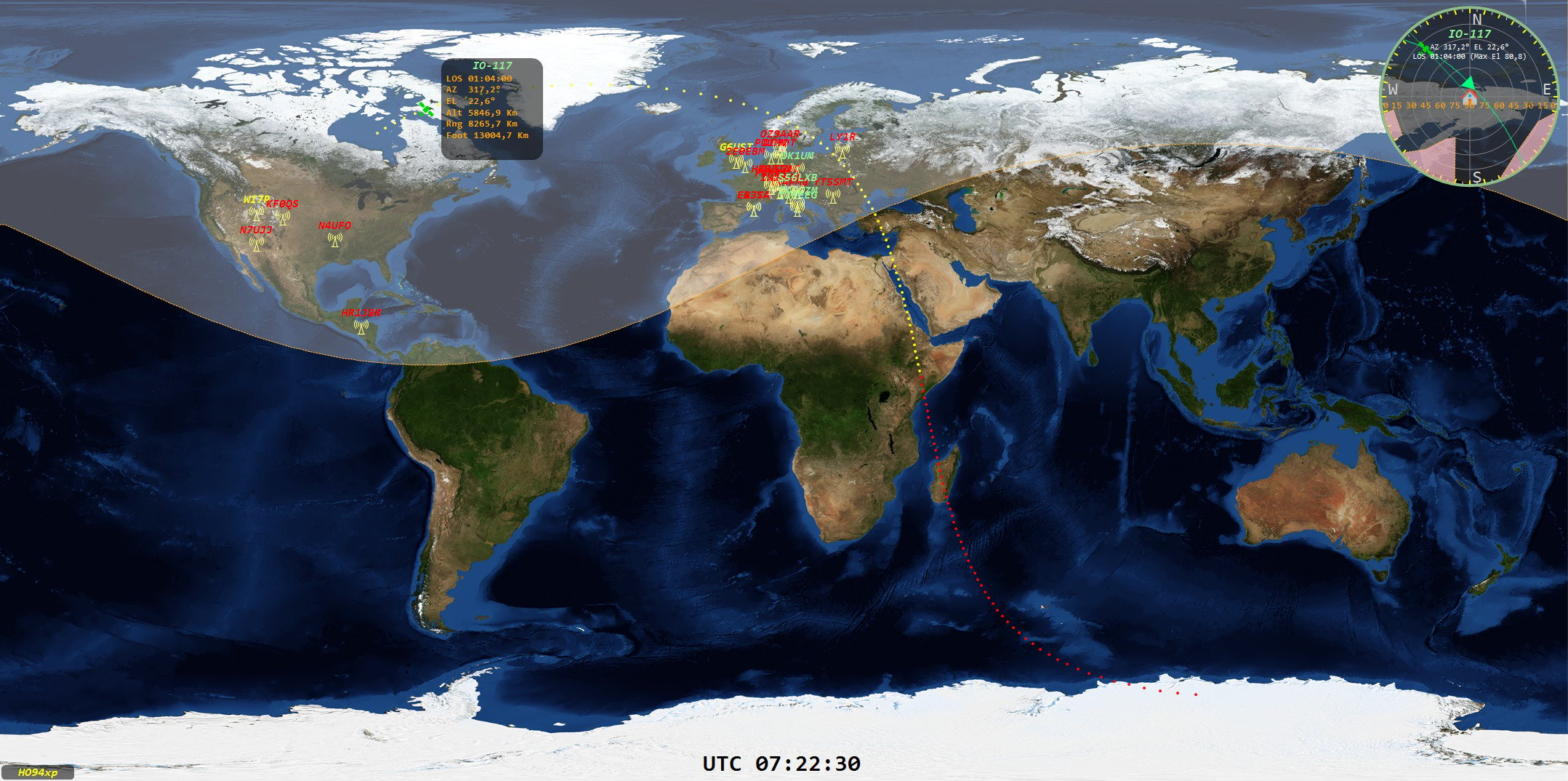 Greencube Terminal Live World View [Credit: Carsten Groen, OZ9AAR]Several user-requested enhancements have been incorporated, including the addition of time stamps (HH:MM:SS) when copying selected lines to the clipboard in the Traffic window and the removal of limitations on the length of callsigns (excluding SSID) in AX.25 mode so the full 6-character callsigns in AX.25 are supported. Additionally, users can now integrate their horizon into the “radar view” in LWV by defining horizon definitions in a text file.
Greencube Terminal Live World View [Credit: Carsten Groen, OZ9AAR]Several user-requested enhancements have been incorporated, including the addition of time stamps (HH:MM:SS) when copying selected lines to the clipboard in the Traffic window and the removal of limitations on the length of callsigns (excluding SSID) in AX.25 mode so the full 6-character callsigns in AX.25 are supported. Additionally, users can now integrate their horizon into the “radar view” in LWV by defining horizon definitions in a text file.
Noteworthy improvements have also been made to message handling within the Terminal program. These include fixes to parsing issues with local TLE data caused by duplicate NORAD numbers and adjustments to the way UHM paints lines in the Traffic view to address reported errors. Furthermore, enhancements to LoTW status checks now ensure that updates occur automatically every 12 hours based on user-configured preferences, streamlining the process and ensuring accuracy.
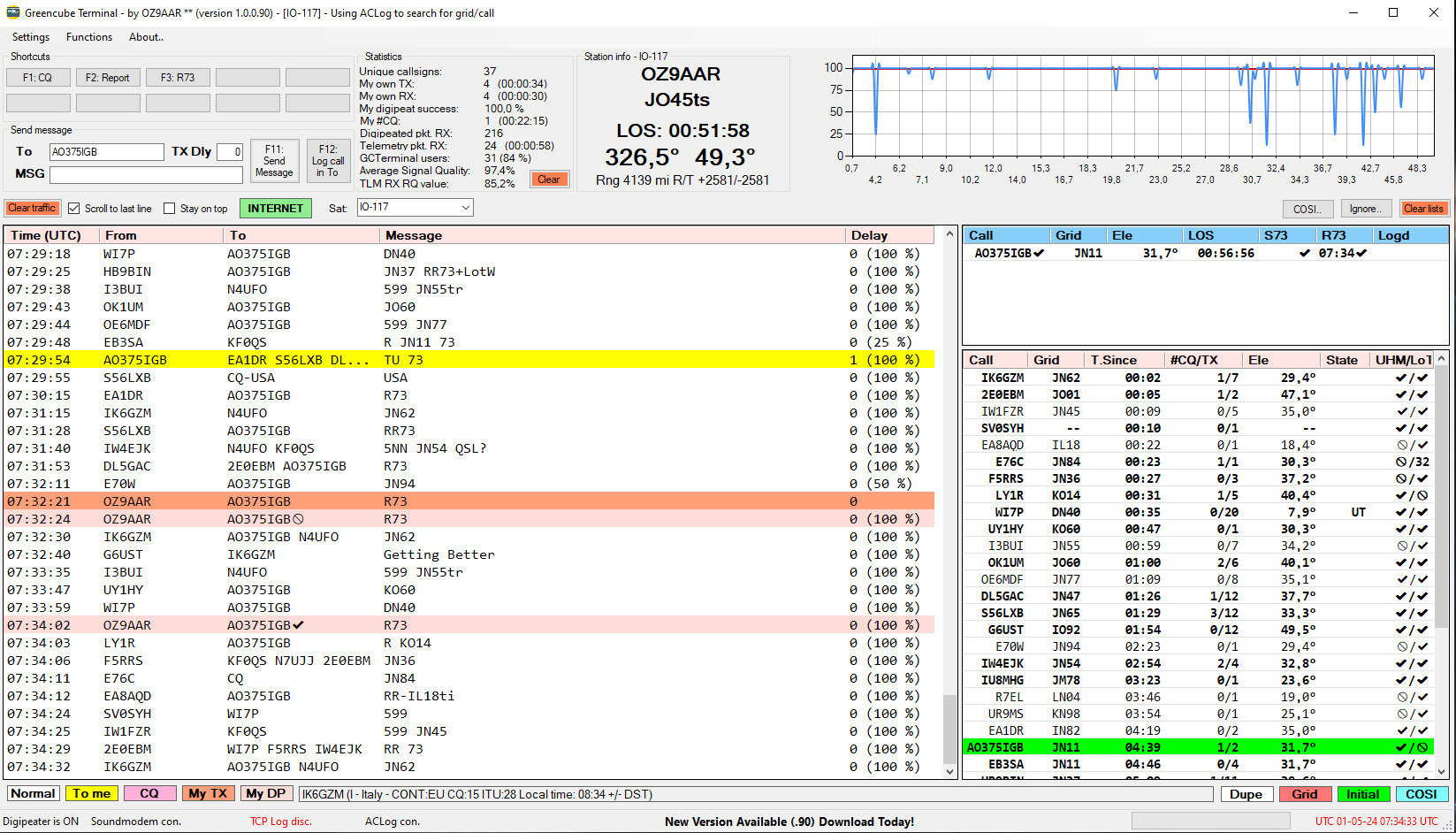 Greencube Terminal Main Screen with UHM 2.1 [Credit: Carsten Groen, OZ9AAR]The introduction of Live QSO Viewer (LQV) and Live World View (LWV) offers users innovative graphical representations of satellite traffic and station locations, enhancing situational awareness and operational efficiency. Additionally, the integration of GPS in version 1.0.0.84 enables users to connect GPS receivers for automatic grid location updates, simplifying tracking and reporting, especially for mobile users.
Greencube Terminal Main Screen with UHM 2.1 [Credit: Carsten Groen, OZ9AAR]The introduction of Live QSO Viewer (LQV) and Live World View (LWV) offers users innovative graphical representations of satellite traffic and station locations, enhancing situational awareness and operational efficiency. Additionally, the integration of GPS in version 1.0.0.84 enables users to connect GPS receivers for automatic grid location updates, simplifying tracking and reporting, especially for mobile users.
With the addition of features such as UHM integration, expanded satellite selection, and improved message handling, users can anticipate a more robust and user-friendly experience with the Greencube Terminal Program v1.0.0.90. These updates underscore a commitment to continuous improvement and innovation, ensuring Greencube Terminal Program remains the most popular application for GreenCube satellite communications. More information about installation, features, and updates can be found on Carsten’s website: https://www.moonbounce.dk/hamradio/greencube-terminal-program.html.
[ANS thanks Carsten Groen, OZ9AAR, for the above information]
Chang’e-6 Successfully Launches: China’s Historic Lunar Mission BeginsChina’s Chang’e-6 mission embarked on its historic journey on May 3rd, launching aboard a Long March 5 rocket from the Wenchang Satellite Launch Center on Hainan Island, China. This mission aims to retrieve samples from the far side of the Moon, a feat never before achieved. The spacecraft is set to undergo a 53-day voyage to the Moon and back, where it will collect lunar soil and rocks, offering invaluable insights into the Moon’s ancient history.
The mission targets the Moon’s South Pole-Aitken (SPA) basin, a region of particular interest due to its potential to unveil crucial information about the Moon’s past. This basin, formed by an ancient impact, holds clues about the events that shaped both the Moon and Earth billions of years ago, providing an opportunity to understand the differences between the near and far sides of the Moon.
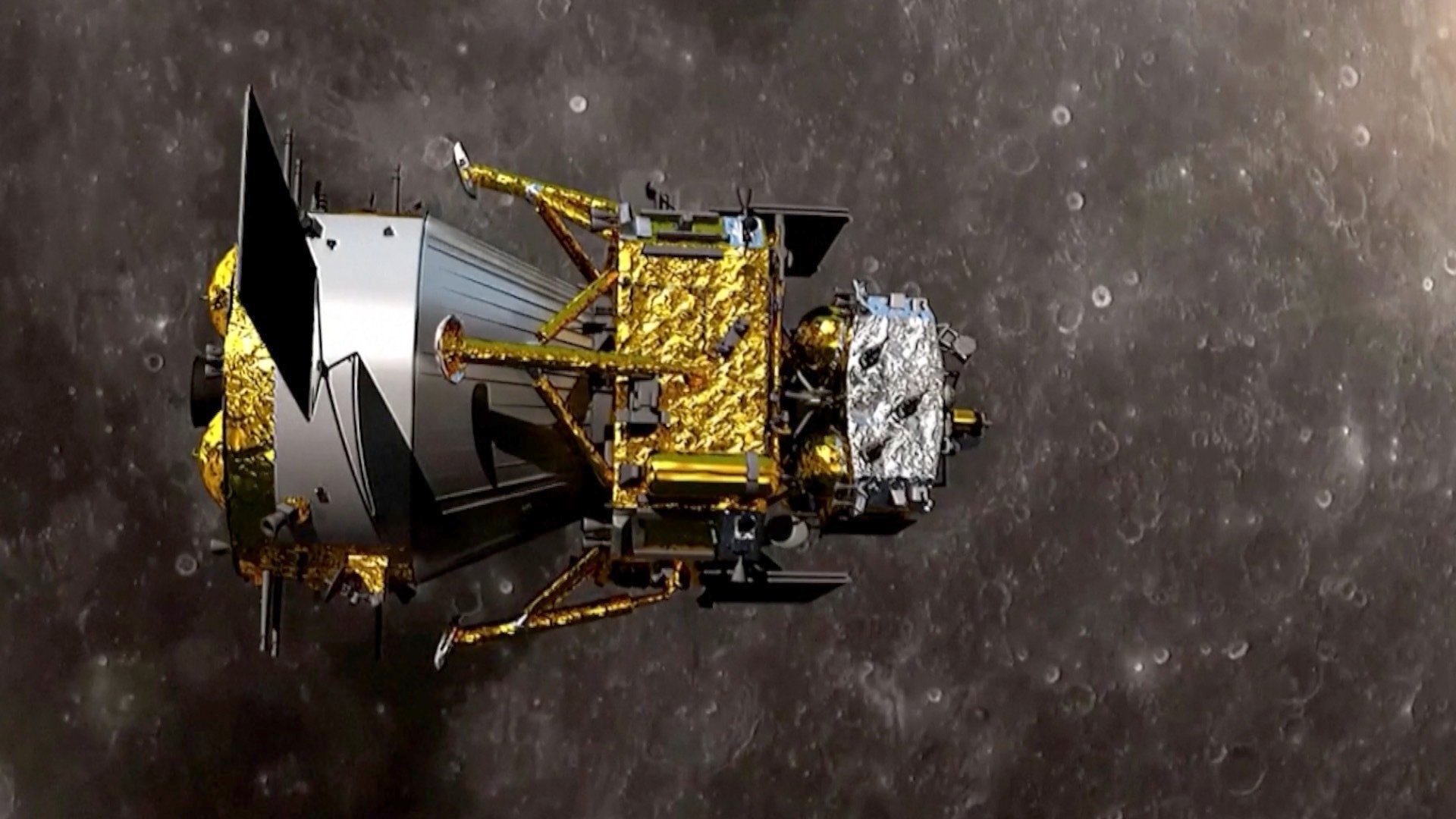 Rendering of Chang’e-6 Spacecraft in Lunar Orbit. [Credit: Chinese National Space Agency (CNSA)]Unlike previous lunar missions, which primarily focused on the near side, Chang’e-6 will explore the challenging terrain of the far side. Landing and communicating on this side of the Moon require sophisticated technology, including communications relay satellites. China, having achieved the first successful lunar far-side landing in 2019 with Chang’e-4, now endeavors to bring back samples from this uncharted territory.
Rendering of Chang’e-6 Spacecraft in Lunar Orbit. [Credit: Chinese National Space Agency (CNSA)]Unlike previous lunar missions, which primarily focused on the near side, Chang’e-6 will explore the challenging terrain of the far side. Landing and communicating on this side of the Moon require sophisticated technology, including communications relay satellites. China, having achieved the first successful lunar far-side landing in 2019 with Chang’e-4, now endeavors to bring back samples from this uncharted territory.
The Chang’e-6 spacecraft is comprised of four components: an orbiter, lander, ascender, and reentry module. Upon reaching lunar orbit, the lander and ascender will descend to the Moon’s surface, collect approximately 2 kilograms (4.4 pounds) of lunar material using specialized tools, and return to lunar orbit. The orbiter will then carry the samples back to Earth, releasing the reentry module into the atmosphere for a soft landing.
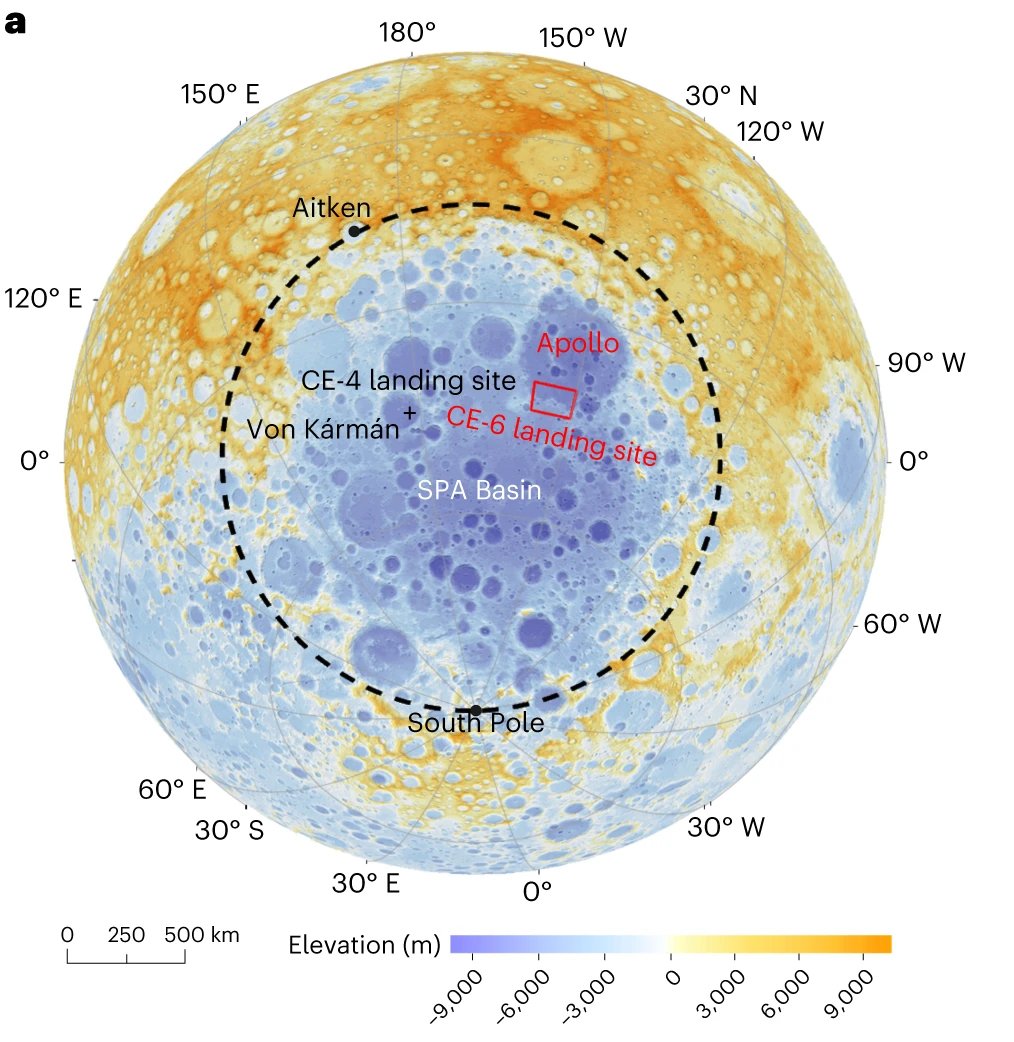 Chang’e-6 Spacecraft’s Landing Site on the Moon’s SPA Basin. [Credit: Chinese National Space Agency (CNSA)]During its 53-day mission, Chang’e-6 will communicate with Earth through the Queqiao-2 relay satellite, which features a large parabolic antenna. This communication link will enable scientists to monitor and control the mission’s progress and ensure the safe return of valuable lunar samples.
Chang’e-6 Spacecraft’s Landing Site on the Moon’s SPA Basin. [Credit: Chinese National Space Agency (CNSA)]During its 53-day mission, Chang’e-6 will communicate with Earth through the Queqiao-2 relay satellite, which features a large parabolic antenna. This communication link will enable scientists to monitor and control the mission’s progress and ensure the safe return of valuable lunar samples.
The scientific significance of Chang’e-6 extends beyond lunar exploration. The samples it retrieves will shed light on the Solar System’s tumultuous past, particularly the Late Heavy Bombardment period around 3.9 billion years ago. By studying the SPA basin’s age and composition, scientists hope to discern the origins of this event and its implications for Earth’s history and the potential for life elsewhere in the universe.
[ANS thanks Jason Davis, The Planetary Society, for the above information]
The 2024 AMSAT President’s Club coins are here now!Help Support GOLF and Fox Plus
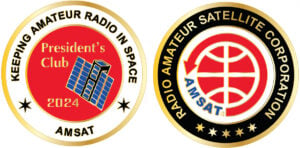 Join the AMSAT President’s Club today and help
Join the AMSAT President’s Club today and help Keep Amateur Radio in Space!
https://www.amsat.org/join-the-amsat-presidents-club/ NASA Reveals SpaceX’s Innovative Plan for Starship Refueling in Orbit
NASA recently outlined SpaceX’s plans for refueling Starships in low-Earth orbit, a critical step toward enabling ambitious lunar missions. Scheduled for next year, this demonstration involves linking two Starships in orbit. Under contract with NASA’s Artemis program, SpaceX aims to supply human-rated Starships for lunar landings, although the targeted 2026 launch for Artemis III highlights the project’s ambitious nature. Last year, NASA awarded a contract to Blue Origin, providing alternative options for lunar missions. Both companies designed their landers with future refueling capabilities, allowing for multiple missions and potential resource utilization on the Moon or Mars.
Amit Kshatriya, leading NASA’s “Moon to Mars” program, outlined SpaceX’s strategy for in-space refueling during a recent meeting. Despite challenges, progress is evident as SpaceX prepares for upcoming Starship test flights, aiming to tackle crucial technical hurdles. Before lunar missions become a reality, mastering in-space refueling is essential. SpaceX plans to demonstrate large-scale propellant transfer between two Starships in orbit next year. This milestone follows a successful cryogenic propellant transfer test during a previous Starship flight, funded by NASA.
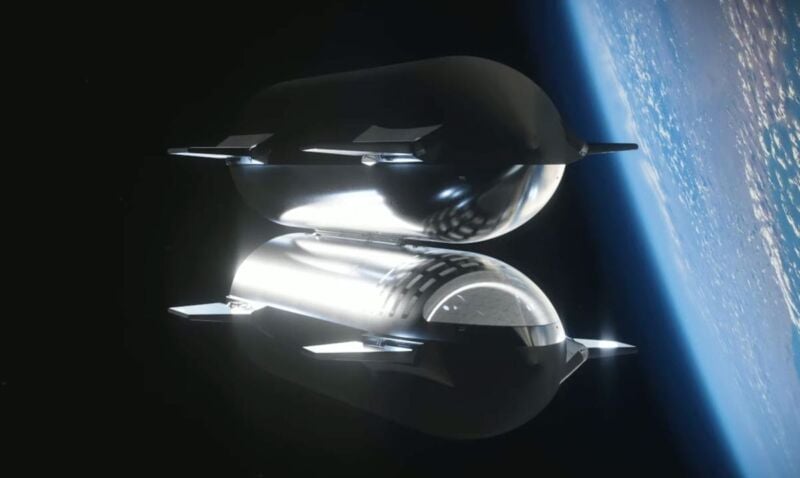 Artist’s Illustration of Two SpaceX Starships Docked in Orbit. [Credit: SpaceX]With each test flight, SpaceX aims to enhance capabilities necessary for lunar landings. These include precise booster landings, in-orbit engine restarts, and controlled reentries—a prerequisite for deep space exploration. SpaceX’s long-term goal of frequent Starship launches hinges on rapid reusability, aligning with Elon Musk’s vision. Despite the challenges, progress is tangible, with plans underway to establish additional launch infrastructure in Texas and Florida.
Artist’s Illustration of Two SpaceX Starships Docked in Orbit. [Credit: SpaceX]With each test flight, SpaceX aims to enhance capabilities necessary for lunar landings. These include precise booster landings, in-orbit engine restarts, and controlled reentries—a prerequisite for deep space exploration. SpaceX’s long-term goal of frequent Starship launches hinges on rapid reusability, aligning with Elon Musk’s vision. Despite the challenges, progress is tangible, with plans underway to establish additional launch infrastructure in Texas and Florida.
The upcoming refueling demonstration involves autonomously linking two Starships in orbit, a task not without complexities. Yet, leveraging experience from Dragon capsule missions, SpaceX aims to navigate these challenges. The propellant transfer process relies on a pressure differential mechanism, simplifying the flow between donor and recipient tanks. Fine-tuning this procedure is crucial to avoid propellant loss during transfers.
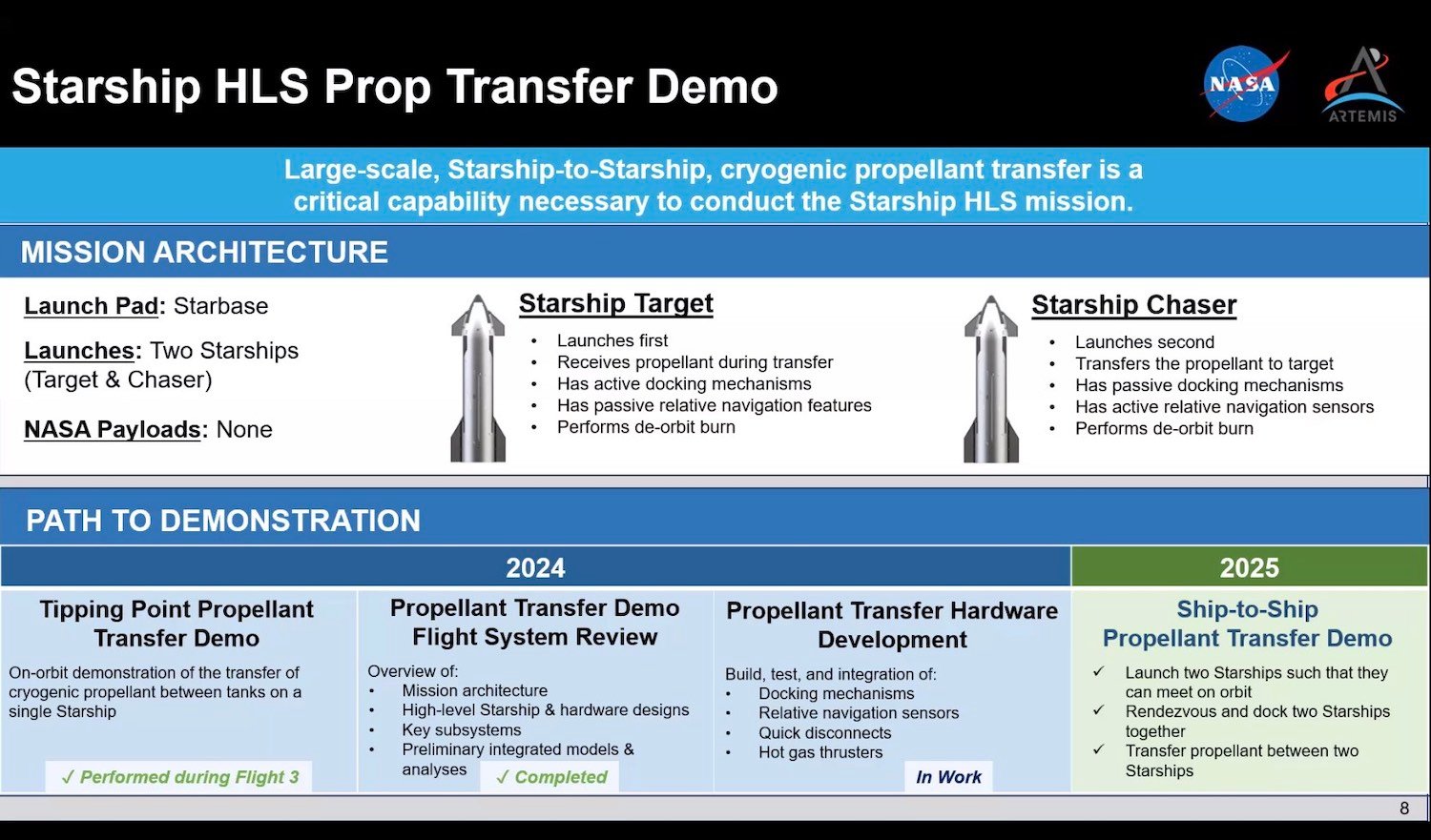 Plans for SpaceX’s Ship-to-Ship Cryogenic Transfer Demonstration. [Credit: NASA/Amit Kshatriya]Success in these demonstrations will determine the number of refueling tankers required for lunar missions. While predictions exist, practical tests will validate these estimates, ensuring mission success. As SpaceX pushes boundaries, industry experts emphasize the importance of collaboration and innovation. With a resilient team and the right attitude, SpaceX aims to overcome challenges and pioneer the next era of space exploration. While ambitious, SpaceX’s endeavors signify a paradigm shift in space exploration, driven by a collective vision of advancing humanity’s reach beyond Earth’s orbit.
Plans for SpaceX’s Ship-to-Ship Cryogenic Transfer Demonstration. [Credit: NASA/Amit Kshatriya]Success in these demonstrations will determine the number of refueling tankers required for lunar missions. While predictions exist, practical tests will validate these estimates, ensuring mission success. As SpaceX pushes boundaries, industry experts emphasize the importance of collaboration and innovation. With a resilient team and the right attitude, SpaceX aims to overcome challenges and pioneer the next era of space exploration. While ambitious, SpaceX’s endeavors signify a paradigm shift in space exploration, driven by a collective vision of advancing humanity’s reach beyond Earth’s orbit.
[ANS thanks Stephen Clark, Ars Technica, for the above information]
GridMasterMap Satellite Top 100 Rovers May 2024 RankingsThe May 2024 rankings for the Top 100 Rovers (Mixed LEO/MEO/GEO) in satellite operations, as determined by @GridMasterMap on Twitter, has been released. The ranking is determined by the number of grids and DXCC entities activated, taking into account only those grids where a minimum number of QSOs logged on the gridmaster.fr website have been validated by a third party. Grid numbers do not directly reflect the exact number of activations. Satellite operators are encouraged to upload their LoTW satellite contacts to https://gridmaster.fr in order to provide more accurate data.
Updated: 2024-05-01
1 ND9M 26 N5BO 51 SP5XSD 76 FG8OJ 2 NJ7H 27 K8BL 52 AD7DB 77 PT9BM 3 JA9KRO 28 LU5ILA 53 JL3RNZ 78 KJ7NDY 4 N5UC 29 KE4AL 54 F4DXV 79 KI7UXT 5 UT1FG 30 DL2GRC 55 KE9AJ 80 YU0W 6 OE3SEU 31 VE3HLS 56 KI7QEK 81 WA9JBQ 7 DL6AP 32 KB5FHK 57 PA3GAN 82 N4DCW 8 WI7P 33 KI7UNJ 58 N8RO 83 HB9GWJ 9 HA3FOK 34 LA9XGA 59 XE1ET 84 KB2YSI 10 K5ZM 35 F4BKV 60 KM4LAO 85 N0TEL 11 N6UA 36 N7AGF 61 VE1CWJ 86 VE3GOP 12 N9IP 37 JO2ASQ 62 SM3NRY 87 KI0KB 13 WY7AA 38 XE3DX 63 N4UFO 88 JM1CAX 14 W5PFG 39 K7TAB 64 VA3VGR 89 CU2ZG 15 AK8CW 40 KE0PBR 65 W1AW 90 K0FFY 16 AD0DX 41 KE0WPA 66 VA7LM 91 KG4AKV 17 DP0POL 42 N6DNM 67 PT2AP 92 AF5CC 18 WD9EWK 43 PR8KW 68 M1DDD 93 VE6WK 19 AD0HJ 44 AC0RA 69 DL4EA 94 W8MTB 20 ON4AUC 45 EB1AO 70 AA8CH 95 VE7PTN 21 KX9X 46 JK2XXK 71 N4AKV 96 DK9JC 22 KG5CCI 47 W7WGC 72 LU4JVE 97 K6VHF 23 ND0C 48 EA4NF 73 VE1VOX 98 N6UTC 24 DJ8MS 49 VK5DG 74 W8LR 99 PT9ST 25 F5VMJ 50 AA5PK 75 DF2ET 100 VO2AC[ANS thanks @GridMasterMap for the above information]
Need new satellite antennas?Purchase an M2 LEO-Pack from the AMSAT Store!
 When you purchase through AMSAT, a portion of the proceeds goes towards
When you purchase through AMSAT, a portion of the proceeds goes towardsKeeping Amateur Radio in Space.
https://amsat.org/product-category/hardware/ Changes to AMSAT-NA TLE Distribution for May 3, 2024
Two Line Elements or TLEs, often referred to as Keplerian elements or keps in the amateur community, are the inputs to the SGP4 standard mathematical model of spacecraft orbits used by most amateur tracking programs. Weekly updates are completely adequate for most amateur satellites. TLE bulletin files are updated daily in the first hour of the UTC day. New bulletin files will be posted immediately after reliable elements become available for new amateur satellites. More information may be found at https://www.amsat.org/keplerian-elements-resources/.
Correction to last week’s addition:
KASHIWA NORAD Cat ID 59508 Correct downlink 437.3753 MHz (Thanks Nico PA0DLO)
The following satellites have been removed from this week’s AMSAT-NA TLE distribution:
NIUSAT NORAD Cat ID 42766 Decayed from orbit on or about 27 April 2024
ExoCube 2 NORAD Cat ID 47319 Decayed from orbit on or about 30 April 2024
[ANS thanks AMSAT Orbital Elements page for the above information]
ARISS NEWSAmateurs and others around the world may listen in on contacts between amateurs operating in schools and allowing students to interact with astronauts and cosmonauts aboard the International Space Station. The downlink frequency on which to listen is 145.800 MHz worldwide.
+ Recently Completed Contacts
Centennial Campus Magnet Middle School Center for Innovation, Raleigh, NC, telebridge via K6DUE
The ISS callsign was NA1SS
The scheduled crewmember was Matthew Dominick KCØTOR
The ARISS mentor was AA6TB
Contact was successful: Wed 2024-05-01 12:03:49 UTC
Watch for Livestream at: https://www.youtube.com/watch?v=lnAZJknxsgw
Wireless Institute of Australia / Bundaberg High School Amateur Radio Club, Bundaberg, Queensland, Australia, telebridge via VK6MJ
The ISS callsign was NA1SS
The scheduled crewmember was Mike Barratt KD5MIJ
The ARISS mentor was VK4KHZ
Contact was successful: Sat 2024-05-04 10:28:24 UTC
+ Upcoming Contacts
Eric Knows CIC, Newcastle upon Tyne, United Kingdom, telebridge via K6DUE
The ISS callsign is presently scheduled to be NA1SS
The scheduled crewmember is Matthew Dominick KCØTOR
The ARISS mentor is MØXTD
Contact is go for: Sat 2024-05-11 08:42:32 UTC
The crossband repeater continues to be active (145.990 MHz up {PL 67} & 437.800 MHz down). If any crewmember is so inclined, all they have to do is pick up the microphone, raise the volume up, and talk on the crossband repeater. So give a listen, you just never know.
The packet system is also active (145.825 MHz up & down).
As always, if there is an EVA, a docking, or an undocking; the ARISS radios are turned off as part of the safety protocol.
Note, all times are approximate. It is recommended that you do your own orbital prediction or start listening about 10 minutes before the listed time.
The latest information on the operation mode can be found at https://www.ariss.org/current-status-of-iss-stations.html
The latest list of frequencies in use can be found at https://www.ariss.org/contact-the-iss.html
[ANS thanks Charlie Sufana, AJ9N, one of the ARISS operation team mentors for the above information]
Upcoming Satellite OperationsA growing number of satellite rovers are currently engaged in sharing their grid square activations on https://hams.at. By visiting the website, you gain easy access to comprehensive information about the operators responsible for activating specific grid squares. Additionally, you have the ability to assess the match score between yourself and a particular rover for a given pass, while also being able to identify the upcoming satellite passes that are accessible from your location.
[ANS thanks Ian Parsons, K5ZM, AMSAT rover page manager, for the above information]
Hamfests, Conventions, Maker Faires, and Other EventsAMSAT Ambassadors provide presentations, demonstrate communicating through amateur satellites, and host information tables at club meetings, hamfests, conventions, maker faires, and other events.
Dayton Hamvention 2024
Friday May 17th – Sunday May 19th
Greene County Fairgrounds and Expo Center
120 Fairground Road
Xenia, OH 45385
https://hamvention.org
38th Annual Small Satellite Conference
August 3-8, 2024
Logan, UT, USA
https://smallsat.org
[ANS thanks the AMSAT Events page for the above information]
Want to fly the colors on your own grid expedition?Get an AMSAT car flag and other neat stuff from our Zazzle store!
25% of the purchase price of each product goes towards Keeping Amateur Radio in Space
 Keeping Amateur Radio in Space
Keeping Amateur Radio in Spacehttps://www.zazzle.com/amsat_gear Satellite Shorts From All Over
+ Congratulations are in order for RJ Bragg, WY7AA, and Andrew Northam, KE8FZT, for their impressive accomplishments in earning GridMaster Awards #64 and #65, respectively! This esteemed recognition, initiated by Star Comm Group in 2014 and backed by Damon Runion, WA4HFN, and Rick Tillman, WA4NVM, has now been entrusted to AMSAT for the benefit of the entire amateur satellite community. The GridMaster Award celebrates radio amateurs worldwide who achieve two-way communication via amateur satellite with operators in all 488 Maidenhead grids across the contiguous United States of America. For more details on this distinguished award, visit the AMSAT website at https://www.amsat.org/gridmaster/. Andrew and RJ, your achievement is truly commendable—well done! (ANS thanks Bruce Paige, KK5DO, AMSAT Director of Contests and Awards for the above information)
+ AMSAT Italia proudly announces the acquisition of ownership of the IO-117 “GreenCube” satellite, with Sapienza University retaining partial ownership. Through collaboration, the satellite will continue amateur radio operations post-primary scientific mission completion, preventing its decommissioning. This transfer of legal responsibility from the Italian Space Agency to AMSAT Italia solidifies the satellite’s exclusive amateur radio use. Originally named GreenCube, it was developed by Sapienza University, ENEA, and University of Naples Federico II, with AMSAT Italia contributing to its design. On October 29, 2022, GreenCube became the first ham radio satellite to operate in a MEO orbit, designated as Italy-OSCAR 117 (IO-117) by AMSAT. AMSAT Italia, Sapienza Space Systems, and Space Surveillance Laboratory commit to operating the satellite for continued service to the amateur radio community. (ANS thanks AMSAT Italia for the above information)
+ Boeing’s Crew Flight Test (CFT) of the CST-100 Starliner spacecraft is scheduled for Monday, May 6, with a targeted launch time of 10:34 p.m. EDT. Led by Commander Barry “Butch” Wilmore and Pilot Suni Williams, both experienced NASA astronauts, this mission comes after over a decade in development. The duo will spend at least eight days aboard the International Space Station (ISS) conducting various flight test objectives before returning for a solid-ground landing. Wilmore and Williams will be the first humans to fly atop the United Launch Alliance (ULA) Atlas V rocket since 1963 and execute the first “land” landing of a crew-carrying U.S. spacecraft since 2011. Originally not slated for this mission, Wilmore and Williams stepped in after several crew changes, with Williams set to become the first woman to fly the maiden voyage of a new orbital-class vehicle. Deep into pre-flight quarantine, the astronauts express their readiness, acknowledging the challenges and the learning opportunities that lie ahead in this ambitious test flight. (ANS thanks Ben Evans, AmericaSpace, for the above information)
+ On April 25, 2024, Roscosmos cosmonauts Oleg Kononenko and Nikolai Chub conducted a successful spacewalk, lasting four hours and 36 minutes, to install communication and corrosion analysis equipment on the International Space Station (ISS). The spacewalk aimed to deploy a communications system and install equipment to analyze corrosion levels on station surfaces. Kononenko, with seven spacewalks under his belt, and Chub, on his second, completed their tasks, including deploying a panel for a synthetic radar communications system on the Russian segment of the ISS. This mission marked the 270th spacewalk for assembly, maintenance, and upgrades of the space station, with Kononenko and Chub having arrived at the station on September 15, 2023, aboard the Soyuz MS-24 spacecraft. (ANS thanks SciTechDaily.com, for the above information)
+ Two new Galileo navigation satellites were launched from Kennedy Space Center on Saturday, April 27th, at 8:34 p.m. EDT, bolstering the system’s constellation to 30 satellites and amplifying reliability and precision for billions of users globally. Since its inception in 2016, Galileo has been pivotal across various sectors such as rail, maritime, agriculture, and rescue operations, contributing significantly to the EU’s GDP, with 10% reliant on satellite navigation. This launch follows the recent introduction of the new Public Regulated Service signals, further solidifying Europe’s independence in satellite navigation. Notably, this marks the first time Galileo satellites have been launched aboard an American-made rocket, a significant development amid Europe’s diminishing space collaboration with Russia. (ANS thanks the European Space Agency, for the above information)
+ SpaceX’s 30th Dragon cargo mission successfully returned to Earth, splashing down off the coast of Florida in the early hours of April 30th. Departing from the International Space Station on April 28th, the capsule completed its mission under the CRS-30 contract with NASA. Loaded with over 4,100 pounds of supplies and scientific experiments, Dragon is unique in its capability to safely bring gear back from the ISS, unlike other operational spacecraft that burn up upon reentry. This return enables quick transportation of experiments to NASA’s facilities for data collection. Meanwhile, another SpaceX vehicle remains docked at the ISS, supporting the Crew-8 astronaut mission for NASA, launched in early March. (ANS thanks Mike Wall, Space.com, for the above information)
Join AMSAT today at https://launch.amsat.org/
In addition to regular membership, AMSAT offers membership to:
* Societies (a recognized group, clubs or organization).
* Primary and secondary school students are eligible for membership at one-half the standard yearly rate.
* Post-secondary school students enrolled in at least half-time status shall be eligible for the student rate for a maximum of 6 post-secondary years in this status.
* Memberships are available for annual and lifetime terms.
Contact info [at] amsat.org for additional membership information.
73 and remember to help Keep Amateur Radio in Space!
This week’s ANS Editor, Mitch Ahrenstorff, ADØHJ
ad0hj [at] amsat.org
AMSAT Italia Enters Into the Ownership of IO-117 “GreenCube” Satellite
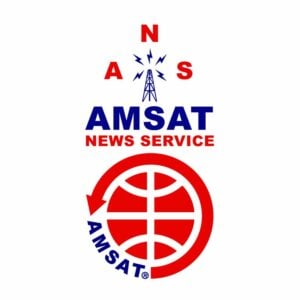
May 2, 2024
In this edition:
- AMSAT Italia Enters Into the Ownership of IO-117 “GreenCube” Satellite
The AMSAT News Service bulletins are a free, weekly news and information service of AMSAT, The Radio Amateur Satellite Corporation. ANS publishes news related to Amateur Radio in Space including reports on the activities of a worldwide group of Amateur Radio operators who share an active interest in designing, building, launching and communicating through analog and digital Amateur Radio satellites.
The news feed on https://www.amsat.org publishes news of Amateur Radio in Space as soon as our volunteers can post it.
Please send any amateur satellite news or reports to: ans-editor [at] amsat.org
You can sign up for free e-mail delivery of the AMSAT News Service Bulletins via the ANS List; to join this list see: https://mailman.amsat.org/postorius/lists/ans.amsat.org/
AMSAT Italia Enters Into the Ownership of IO-117 “GreenCube” Satellite Rome, April 30, 2024 – AMSAT Italia is proud to announce the acquisition of the quote of property of the IO-117 “GreenCube” satellite. The other part of the property remains on behalf of “Sapienza University”, Rome, Italy.A collaborative work of the parts will let the satellite continue the amateur radio operations after the completion of the primary scientific mission. This will definitively avert the satellite decommissioning process by transferring the legal responsibility of the satellite from the Italian Space Agency to AMSAT Italia. Even formally and legally, the satellite, already known with its original name of GreenCube, becomes for the exclusive use of amateur radio. The scientific community continue the study of the behavior of this type of satellite placed in MEO orbit.
GreenCube was designed and developed by Sapienza University, ENEA and University of Naples Federico II for the Italian Space Agency. AMSAT Italia contributed to design the digipeater and supported amateur radio operations. IARU coordinated the use of the operations in the amateur radio frequency bands.
The satellite was carried on the qualification flight of Vega-C launcher on July 13, 2022 from the French Guiana Space Center in Kourou. On October 29, 2022, the on-board digipeater was activated, allowing GreenCube to become the first ham radio satellite to operate in a MEO orbit. Being a radio amateur worldwide success, AMSAT officially designated the satellite as Italy-OSCAR 117 (IO-117).
AMSAT Italia and Sapienza Space Systems and Space Surveillance Laboratory – S5LAB- are now committed to operate the satellite and to continue to offer the service to the amateur radio community.
For further information please contact AMSAT Italia at segreteria at amsat.it.
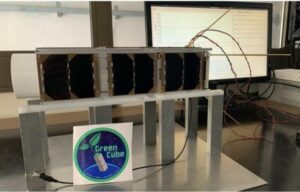
The original press release can be found at https://www.amsat.org/wordpress/wp-content/uploads/2024/05/AMSAT_Italia_acquires_the_IO-117_Greencube_satellite.pdf
[ANS thanks AMSAT Italia for the above information]
Join AMSAT today at https://launch.amsat.org/
In addition to regular membership, AMSAT offers membership to:
- Societies (a recognized group, clubs or organization).
- Primary and secondary school students are eligible for membership at one-half the standard yearly rate.
- Post-secondary school students enrolled in at least half time status shall be eligible for the student rate for a maximum of 6 post-secondary years in this status.
- Memberships are available for annual and lifetime terms.
Contact info [at] amsat.org for additional membership information.
73 and remember to help Keep Amateur Radio in Space!
This week’s ANS Contributing Editor,
Paul Stoetzer, N8HM
n8hm [at] amsat.org
ANS is a service of AMSAT, the Radio Amateur Satellite Corporation, 712 H Street NE, Suite 1653, Washington, DC 20002
ANS-119 AMSAT News Service Weekly Bulletins

April 28, 2024
In this edition:
- AO-109 Re-enters
- AMSAT at Hamvention
- Robusta-3A With Store & Forward Repeater Scheduled for Launch
- Changes to AMSAT-NA TLE Distribution for April 26, 2024
- ARISS News
- Upcoming Satellite Operations
- Hamfests, Conventions, Maker Faires, and Other Events
- Satellite Shorts From All Over
The AMSAT News Service bulletins are a free, weekly news and information service of AMSAT, The Radio Amateur Satellite Corporation. ANS publishes news related to Amateur Radio in Space including reports on the activities of a worldwide group of Amateur Radio operators who share an active interest in designing, building, launching and communicating through analog and digital Amateur Radio satellites.
The news feed on https://www.amsat.org publishes news of Amateur Radio in Space as soon as our volunteers can post it.
Please send any amateur satellite news or reports to: ans-editor [at] amsat.org
You can sign up for free e-mail delivery of the AMSAT News Service Bulletins via the ANS List; to join this list see: https://mailman.amsat.org/postorius/lists/ans.amsat.org/
AO-109 Re-enters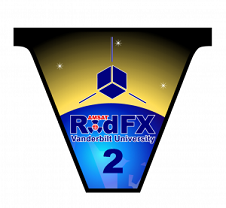
AO-109’s orbit decayed on or about April 21, 2024 after just over three years in space.
Launched on January 17, 2021, as part of the ELaNa 20 mission using a LauncherOne rocket operated by Virgin Orbit, AO–109, known prior to launch as RadFxSat-2 / Fox-1E, was carried aloft by a modified Boeing 747 named “Cosmic Girl” from the Mojave Air and Space Port in California, United States. After reaching an altitude of approximately 35,000 feet (11,000 meters), the rocket was released into space. This launch, conducted under NASA’s CubeSat Launch Initiative program, marked the beginning of the satellite’s mission to facilitate amateur radio communications and technology research. A video of the launch can be seen on YouTube.
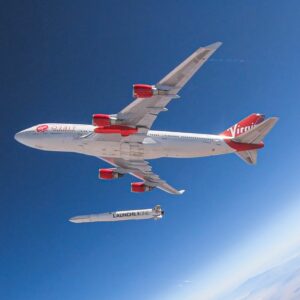
AO–109 represented the fifth iteration of the “Fox” 1U amateur radio satellites series developed by AMSAT, featuring a 30KHz linear transponder radio.
After launch, AMSAT’s Engineering and Operations teams listened for the expected beacon signal, but nothing was initially heard. On January 27, 2021, Brad Schumacher, W5SAT, was able to hear his weak CW signals relayed through the satellite’s transponder. This was confirmed by AMSAT Engineering and Operations the next day and the satellite was designated AMSAT-OSCAR 109. Continued monitoring confirmed that the satellite was operating properly, but with an extremely low signal output. It is likely that the satellite’s final power amplifier transistor failed, limiting power output to just 8 mW.
Although the signal was extremely weak, the satellite was able to support QSOs by CW, FT4/8, and even SSB. Five amateur stations successfully copied the weak telemetry signal from the satellite and provided valuable data about the health of the satellite: the PI9CAM radio telescope in Dwingeloo, Netherlands, provided the bulk of the data from the satellite. WA7FWF, W7KKE, K8DP, and the AMSAT Operations team also copied telemetry.
Upon being declared operational and open for amateur use, despite the limitation of its low power output, on July 20, 2021, AO–109 embarked on a mission to serve both amateur radio and technology research objectives.
The final telemetry data was received on April 5, 2024 from PI9CAM and revealed that the satellite had achieved a remarkable milestone: AO-109 had set a new Fox-1 program record for processor uptime. This information was gathered by Alan Biddle, WA4SCA, who has meticulously monitored telemetry reports on a daily basis and calculated the duration of each reset, allowing for precise correlation of telemetry frames with UTC time.
The Fox satellites are designed to undergo onboard computer resets triggered by factors like radiation exposure and low battery voltage. Time on these satellites is measured by counting resets plus the duration since the last reset. It is common for the Fox satellites to reset every few days or weeks, especially when passing over the South Atlantic Anomaly. However, the processor on AO-109 ran continuously from September 2023 until at least April 5, 2024, accumulating over 18 million seconds of uptime—far surpassing any other Fox satellite.
Among its key payloads was the RadFx-2 experiment, a collaboration with Vanderbilt University, aimed at studying the effects of space radiation on specific SRAM types. Consistent with the Fox-1A design blueprint, AO-109 was equipped with a 2-meter whip antenna and a 70 cm whip antenna.
The linear transponder module developed for AO-109 also evolved into a program to equip other CubeSats with linear transponders. Evolutions of this transponder previously flew aboard HO-107 (HuskySat-1) and the next one is scheduled to fly aboard MESAT-1 later this year. AMSAT’s GOLF program will also carry this linear transponder module for VHF/UHF communications.
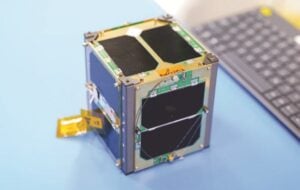
[ANS thanks AMSAT Operations and Engineering for the above information]
AMSAT at Hamvention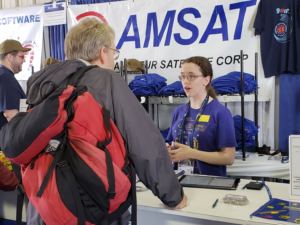
Hamvention is just weeks away at the Greene County Fairgrounds in Xenia, OH May 17-19, 2024! AMSAT will have our usual robust presence and after-hours activities.
Volunteer at the AMSAT Booth – (Building 1, 1007-1010 & 1107-1110)
AMSAT is actively seeking volunteers to assist with booth activities and invites enthusiasts to dedicate their time. Last year, around 20 volunteers played crucial roles in fostering meaningful interactions with attendees. Volunteers, whether able to commit a few hours or the entire weekend, are warmly encouraged to participate.
Aligned with this year’s theme of “Expanding our Community,” AMSAT aims to strengthen its presence by recruiting new members and volunteers. For those eager to be part of AMSAT’s presence at Dayton Hamvention or request more information about volunteering, Phil Smith, W1EME, AMSAT Hamvention Team Leader, serves as the point of contact. To volunteer or inquire further, individuals can reach out to Phil via email at w1eme [at] amsat.org. Your involvement not only enriches the event but also contributes to the vibrant amateur radio community.
AMSAT Forum – Saturday, May 18th
The AMSAT Forum will take place in Forum Room 2 at 1:20pm – 2:50pm on Saturday, May 18th. This will immediately follow the ARISS Forum in the same room at 12:10pm, so get there early and see both presentations!
AMSAT Dinner at Tickets – Thursday, May 16th
The annual AMSAT “Dinner at Tickets” party will be held at Tickets Pub & Eatery on Thursday, May 16th from 6:00 PM to 8:00 PM EDT. There is no program or speaker – just good conversation. Everyone is invited regardless of whether or not they helped with setup or plan to work in the booth. Tickets has a great selection of Greek and American food and great company! Food can be ordered from the menu; drinks (beer, wine, sodas and iced tea) are available at the bar.
Come as you are; no reservations required. Bring some friends and have a great time the night before Hamvention. Tickets Pub & Eatery is located at 7 W. Main St, Fairborn, OH 45324. (Telephone (937) 878-9022)
AMSAT/TAPR Banquet – Friday, May 17th
The 15th annual AMSAT/TAPR Banquet will be held at the Kohler Presidential Banquet Center on Friday, May 17th at 18:30 EDT. This dinner is always a highlight of the TAPR (Tucson Amateur Packet Radio) and AMSAT (Radio Amateur Satellite Corp.) activities during the Dayton Hamvention. This year’s banquet speaker will be Bill Reed, NX5R, AMSAT PACSAT Project Manager, who will highlight the forthcoming PACSAT digital communications payload.
The Kohler Presidential Banquet Center is located at 4548 Presidential Way, Kettering, Ohio – about 20 minutes away from the Greene County Fairgrounds.
Tickets ($60 each) may be purchased from the AMSAT store. The banquet ticket purchase deadline is Friday, May 10th. Banquet tickets must be purchased in advance and will not be sold at the AMSAT booth. There will be no tickets to pick up at the AMSAT booth. Tickets purchased on-line will be maintained on a list with check-in at the door at the banquet center. Seating is limited to the number of meals reserved with the Kohler caterers based on the number of tickets sold by the deadline.
[ANS thanks the AMSAT Hamvention Team for the above information]
Robusta-3A With Store & Forward Repeater Scheduled for LaunchRobusta-3A is a 3U CubeSat with multiple mission
1) Amateur: Store & forward repeater, refer to 5.5 paragraph for more details.
2) Educational: No less than 300 students participated in the development of the platform. As part of their training, a module is allocated to the initiation to amateur radio. In addition, we pass the license to around ten students each year with the ANFR (French administration) and 3 new operators at CSUM.
3) Technical validation mission: An S-band transmitter is on board operating in commercial band for test purposes. This payload will not be controlled by the amateur radio band.
The HAM radio messaging system provides a message-exchanging service between amateur radio users using Robusta satellite missions as relays. The main purpose of the system is to enable HAM radio operators to send and receive messages from anywhere in the world without having a direct (end-to-end) connection between them. The messaging system uses a method called ‘store and forward’ to provide this service. Messages are transported to the relay station (satellite) by a radio link, and from one geographical location to another, by the satellite orbital movement. A user sends a message to the satellite during a pass and the message is stored in the satellite’s memory. The satellite then moves on its orbit, making the stored message available for other HAM radio operators. Users can request messages to the satellite which, in turn will check if there are any stored messages available for that particular operator. Finally, the message is transmitted and it arrives at its destination
A UHF downlink using 9k6 GMSK with AX25 is proposed. Launch is planned on the Ariane 6 maiden flight from Kourou, French Guiana into a 580 km circular 96 degree orbit together with GRBBEta and ISTSAT. More info at https://csum.umontpellier.fr/en/nanosatellites-projects-our-3u-projects/
[ANS thanks the IARU for the above information]
The 2024 Coins Are Here Now!Help Support GOLF and Fox Plus.
Join the AMSAT President’s Club today!

Two Line Elements or TLEs, often referred to as Keplerian elements or keps in the amateur community, are the inputs to the SGP4 standard mathematical model of spacecraft orbits used by most amateur tracking programs. Weekly updates are completely adequate for most amateur satellites. TLE bulletin files are updated Thursday evenings around 2300 UTC, or more frequently if new high interest satellites are launched. More information may be found at https://www.amsat.org/keplerian-elements-resources/
The following satellite has been added to this week’s AMSAT-NA TLE distribution:
KASHIWA NORAD Cat ID 59508 Downlink 437.3794 MHz
The following satellite has been removed from this week’s AMSAT-NA TLE distribution:
AO-109 NORAD Cat ID 47311 Decayed from orbit on or about 21 April 2024
[ANS thanks Joe Fitzgerald, KM1P, AMSAT Orbital Elements Manager, for the above information]
Need new satellite antennas?Purchase an M2 LEO-Pack from the AMSAT Store! When you purchase through AMSAT, a portion of the proceeds goes towards Keeping Amateur Radio in Space.

Amateurs and others around the world may listen in on contacts between amateurs operating in schools and allowing students to interact with astronauts and cosmonauts aboard the International Space Station. The downlink frequency on which to listen is 145.800 MHz worldwide.
Centennial Campus Magnet Middle School Center for Innovation, Raleigh, NC, telebridge via K6DUE
The ISS callsign is presently scheduled to be NA1SS
The scheduled crewmember is Matthew Dominick KCØTOR
The ARISS mentor is AA6TB
Contact is go for: Wed 2024-05-01 12:03:49 UTC 76 deg
Watch for Livestream at: https://youtube.com/live/4ZU7I208cw4
Wireless Institute of Australia / Bundaberg High School Amateur Radio Club, Bundaberg, Queensland, Australia, telebridge via VK6MJ
The ISS callsign is presently scheduled to be NA1SS
The scheduled crewmember is Mike Barratt KD5MIJ
The ARISS mentor is VK4KHZ
Contact is go for: Sat 2024-05-04 10:28:24 UTC 51 deg
As always, if there is an EVA, a docking, or an undocking; the ARISS radios are turned off as part of the safety protocol.
The crossband repeater continues to be active (145.990 MHz up {PL 67} & 437.800 MHz down), If any crewmember is so inclined, all they have to do is pick up the microphone, raise the volume up, and talk on the crossband repeater. So give a listen, you just never know.
Note, all times are approximate. It is recommended that you do your own orbital prediction or start listening about 10 minutes before the listed time.
The latest information on the operation mode can be found at https://www.ariss.org/current-status-of-iss-stations.html
The latest list of frequencies in use can be found at https://www.ariss.org/contact-the-iss.html
[ANS thanks Charlie Sufana, AJ9N, one of the ARISS operation team mentors for the above information]
Upcoming Satellite Operations Quick Hits:None
Major Roves: K6VHF will be active on IO-117 as HR9/K6VHF from EK66 Roatan, Honduras[ANS thanks Ian Parsons, K5ZM, AMSAT Rover Page Manager, and Alex Ners, K6VHF, for the above information]
Want to fly the colors on your own grid expedition?Get an AMSAT car flag and other neat stuff from our Zazzle store!
25% of the purchase price of each product goes towards Keeping Amateur Radio in Space
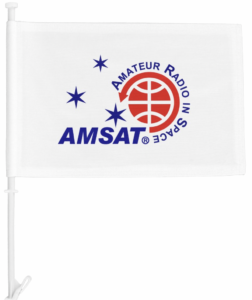
AMSAT Ambassadors provide presentations, demonstrate communicating through amateur satellites, and host information tables at club meetings, hamfests, conventions, maker faires, and other events.
AMSAT Ambassador Clint Bradford, K6LCS, says,
“Two “different” audiences last week invited me to speak. The Mount Baker Amateur Radio Club in Bellingham, WA, was a ham club – and we had a great time.”
“But the Orange County (CA) Astronomers Club was a little, well, different. But there was plenty of “crossover” interests: space photography, studies of our planets … so it wasn’t a 100-percent “ham” audience. But I edited and came up with a presentation they said they enjoyed!”“Think a 75-minute presentation on “working the easy satellites” would be appropriate for your club or event? Let me know by emailing me at k6lcsclint (at) gmail (dot) com or calling me at 909-999-SATS (7287)!”
Clint has NEVER given the exact same show twice: EACH of the 150+ presentations so far has been customized/tailored to their audiences.
Scheduled EventsDayton Hamvention 2024
Friday May 17th through Sunday May 19th, 2024
Greene County Fairgrounds and Expo Center
120 Fairground Road
Xenia, OH 45385
https://hamvention.org
[ANS thanks Clint Bradford, K6LCS, and AMSAT for the above information]
Satellite Shorts from All Over+ David Bowman, G0MRF, and Graham Shirville, G3VZV, will travel to St. Johns, Newfoundland May 15-19, 2024 in an attempt to operate QO-100 from below the horizon and claim trophies sponsored by AMSAT-UK and the British Amateur Television Club for the first QO-100 QSOs from North America. AMSAT-UK and BATC posed the challenge in 2022. The trophies have so far gone unclaimed, though successful below horizon operation on QO-100 has occurred from Indonesia. (ANS thanks David Bowman, G0MRF, for the above information)
+ Members of the AMSAT Engineering team attended the CubeSat Developer’s Workshop in San Luis Obispo, CA this past week. The workshop offered an opportunity for AMSAT Engineers to network with other CubeSat developers and learn about the most recent developments in space technology as applied to CubeSats.
+ The U.S. space agency says its Voyager-1 probe is once again sending usable information back to Earth after months of spouting gibberish. The 46-year-old NASA spacecraft is humanity’s most distant object. A computer fault stopped it returning readable data in November but engineers have now fixed this. For the moment, Voyager is sending back only health data about its onboard systems, but further work should get the scientific instruments back online. Voyager-1 is more than 24 billion km (15 billion miles) away, so distant, its radio messages take a full 22.5 hours to reach us. (ANS thanks BBC News for the above information.)
+ In Colorado Springs, Colorado, students at the Thrive Home School Academy (THSA), along with students at Stratton Meadows Elementary (SME), were able to have a space chat with NASA astronaut and mission specialist Jeanette “Jo” Epps, KF5QNU, on board the International Space Station (ISS) on April 22, 2024. At the time of the contact Epps, a member of the SpaceX Crew-8 mission, was on her 47th day of the 180-day mission. (ANS thanks the ARRL Letter for the above information.)
Join AMSAT today at https://launch.amsat.org/
In addition to regular membership, AMSAT offers membership to:
- Societies (a recognized group, clubs or organization).
- Primary and secondary school students are eligible for membership at one-half the standard yearly rate.
- Post-secondary school students enrolled in at least half time status shall be eligible for the student rate for a maximum of 6 post-secondary years in this status.
- Memberships are available for annual and lifetime terms.
Contact info [at] amsat.org for additional membership information.
73 and remember to help Keep Amateur Radio in Space!
This week’s ANS Editor,
Paul Stoetzer, N8HM
n8hm [at] amsat.org
ANS is a service of AMSAT, the Radio Amateur Satellite Corporation, 712 H Street NE, Suite 1653, Washington, DC 20002
ANS-112 AMSAT News Service Weekly Bulletins
In this edition:
- Nine US Schools Moved Forward in ARISS Selection Process
- AMSAT Thanks First Quarter 2024 President’s Club Members
- AMSAT Engineering Team Powering Up for Hamvention
- Changes to AMSAT-NA TLE Distribution for April 19, 2024
- ARISS News
- Upcoming Satellite Operations
- Hamfests, Conventions, Maker Faires, and Other Events
- Satellite Shorts From All Over
The AMSAT News Service bulletins are a free, weekly news and information service of AMSAT, the Radio Amateur Satellite Corporation. ANS publishes news related to Amateur Radio in Space including reports on the activities of a worldwide group of Amateur Radio operators who share an active interest in designing, building, launching and communicating through analog and digital Amateur Radio satellites.
The news feed on http://www.amsat.org publishes news of Amateur Radio in Space as soon as our volunteers can post it.
Please send any amateur satellite news or reports to: ans-editor [at] amsat [dot] org.
You can sign up for free e-mail delivery of the AMSAT News Service Bulletins via the ANS List; to join this list see: https://mailman.amsat.org/postorius/lists/ans.amsat.org/
ANS-112 AMSAT News Service Weekly Bulletins
To: All RADIO AMATEURS
From: Radio Amateur Satellite Corporation
712 H Street NE, Suite 1653
Washington, DC 20002
DATE 2024 Apr 21
Nine US Schools Moved Forward in ARISS Selection ProcessAmateur Radio on the International Space Station (ARISS) announced on April 18, 2014 the US schools/host organizations newly selected for 2024 ARISS contacts. A total of 9 of the submitted proposals during the recent proposal window have been accepted to move forward in the processes of planning to host a scheduled amateur radio contact with crew on the ISS. The primary goal of the ARISS program is to engage young people in Science, Technology, Engineering, Arts and Math (STEAM) activities and raise their awareness of space communications, radio communications, space exploration, and related areas of study and career possibilities.

The ARISS program anticipates that NASA will be able to provide scheduling opportunities for the 9 US host organizations during the July – December 2024 time period. They are now at work starting to implement their 4–6-month education plan which was outlined in their proposal. These STEAM based educational activities help prepare students for their contact as well as create an on-going exploration and interest in aerospace and amateur radio topics. They are also completing an acceptable equipment plan that demonstrates their ability to execute the ham radio contact. Once their equipment plan is approved by ARISS, the final selected schools/organizations will be scheduled as their availability and flexibility match up with the scheduling opportunities offered by NASA.
The schools and host organizations are:
- Arizona Science Center, Phoenix, AZ
- Bayou Academy, Cleveland, MS
- Bishop O’Connell High School, Arlington, VA
- Greenville Junior High School, Greenville, IL
- Hillsboro Charter Academy, Purcellville, VA
- Pacific Science Center, Seattle, WA
- Sally Ride Elementary School, Orlando, FL
- South Carolina Regional Workforce Advisors-Office of Statewide Workforce Development, Columbia, SC
- TEACH-NW Charter School, Springfield, OR
[ANS thanks Dave Jordan, AA4KN, for the above information.]

The 2024 AMSAT President’s Club coins are here now!
Help Support GOLF and Fox Plus
Join the AMSAT President’s Club today and help
Keep Amateur Radio in Space!
https://www.amsat.org/join-the-amsat-presidents-club/
Frank Karnauskas, N1UW, AMSAT VP – Development happily reports, “Each year for the past four years of its re-incarnation, the AMSAT President’s Club has picked up speed and becomes a more important factor in AMSAT’s annual fund raising efforts. The first quarter of the 2024 the President’s Club is off to a great start. With our regular dedicated contributors plus many first-time members, contributions have already raised almost $16,000 in the first three months of 2024.
“So often, our members think about AMSAT’s having to raise funds for satellite hardware – the costs for electronic components, solar panels, batteries and so on. But, there are many background costs. A good example is software licenses needed for actual satellite development. The volunteer engineers can often swap licenses so they can limit the number of licenses needed. But, as they draw closer to finalizing drawings for circuit boards, spaceframes and deployable solar panels, the team can stretch software licenses only so far before work flow becomes handicapped. Some software licenses, even with the best educational or non-profit discounts, easily exceed the $1,000 mark. And, those licenses need to be renewed on an annual basis.
“The engineering team can always use more electrical and mechanical engineers to move the FOX-PLUS and GOLF programs along. But, being able to leverage the efforts of our current volunteers with enough software licenses would be a huge plus. Contributions from members of the President’s Club make a big difference in giving the engineering team the tools they need.”
To date, the generous donors members of the 2024 AMSAT President’s Club include:
- Titanium ($4,800+)
Barry Baines, WD4ASW
William Brown, K9LF - Gold ($1,200+)
Anonymous
Burns Fisher, WB1FJ
John Kludt, K7SYS
Glenn Miller, AA5PK - Silver ($600+)
Donald Coker, KM6TRZ
Richard Dittmer, KB7SAT
Mark Johns, K0JM
Joseph, Lynch,N6CL
Bruce Paige, KK5DO
Jason Schwarz, N4JJS - Bronze ($300+)
Donald Pettigrew, K9ECT
Dave Taylor, W8AAS - Core ($120+)
David Batzle, N2VDY
Robert Beatty, WB4SON
Alan Boggs, K7IIV
James Gallagher III, KB3SQS
David Hartrum, WA3YDZ
Steven Husey, KB1UOJ
William Pesci, N4WLP
Paul Stoetzer, N8HM
Stefan Wagener, VE4SW
Wayne Wagner, AG1A
Members can learn more about joining the President’s Club at https://www.amsat.org/join-the-amsat-presidents-club/.
[ANS thanks Frank Karnauskas, N1UW, AMSAT VP – Development for the above information.]
Need new satellite antennas?
Purchase M2 LEO-Packs from the AMSAT Store.

When you purchase through AMSAT, a portion of the proceeds goes towards
Keeping Amateur Radio in Space.
https://amsat.org/product-category/hardware/
Given hams’ inherent interest in all things technical, it’s no wonder that the Engineering table at AMSAT’s Hamvention booth is always popular. Not wanting to disappoint our members, Jerry Buxton, N0JY, AMSAT VP- Engineering and his team are making plans for an informative and entertaining presence. No fewer than ten members of the engineering team will attending this year’s Hamvention.
Probably the most interesting exhibit will be a full-scale model of the GOLF-TEE (Technology Exploration Environment) satellite. The 3-D model printed by team member Tom Karnauskas, N0UW, gives an interesting look at the challenges that satellite designers face when trying to fit stacks of circuit boards, bundles of batteries, attitude sensing and control systems, and experimental payloads inside a 10cm x 10cm x 30cm spaceframe. The model also gives a look at the challenge of adding deployable solar panels to the exterior of the spacecraft. Given the fact that the GOLF program represents AMSAT’s return to Highly Elliptical Orbit (HEO), engineers will no-doubt be busy answering questions on all facets of the GOLF program.
Engineers will also be on hand to answer questions about the ongoing development of the Fox-Plus series of satellites. Recognizing the success of the original Fox series as an entry level introduction to amateur satellites, the engineers working the Fox-Plus birds are committed to improving on the original concept and setting the stage for future capabilities for these Low Earth Orbit (LEO) satellites.
For those interested in a look even further into the future, engineers working the ASCENT program will also be present. ASCENT, meaning, Advanced Satellite Communication and Exploration of New Technology, is a “sandbox” for future satellite communications and related systems to be explored and pursued for eventual flight use. A radiation-tolerant internal-housekeeping-unit (RT-IHU), software defined radio (SDR) methods, and a 10 GHz PA design ideas are some ASCENT projects that will fly on GOLF-TEE. Engineers at the table can also discuss other ASCENT projects in the works such as a slow-scan television (SSTV) payload, a packet repeater payload and propulsion systems suitable for CubeSat operation.
[ANS thanks the AMSAT Engineering Team for the above information.]
Want to fly the colors on your own grid expedition?
Get your AMSAT car flag and other neat stuff from our Zazzle store!

25% of the purchase price of each product goes towards
Keeping Amateur Radio in Space
https://www.zazzle.com/amsat_gear
Two Line Elements or TLEs, often referred to as Keplerian elements or keps in the amateur community, are the inputs to the SGP4 standard mathematical model of spacecraft orbits used by most amateur tracking programs. Weekly updates are completely adequate for most amateur satellites. TLE bulletin files are updated daily in the first hour of the UTC day. New bulletin files will be posted immediately after reliable elements become available for new amateur satellites. More information may be found at https://www.amsat.org/keplerian-elements-resources/.
The following satellites have been removed from this week’s AMSAT-NA TLE distribution:
- Clark sat-1 NORAD Cat ID 58613 Decayed from orbit on or about 16 April 2024
- AISTechSat 3 NORAD Cat ID 44103 Decayed from orbit on or about 18 April 2024
[ANS thanks Joe Fitzgerald, KM1P, AMSAT Orbital Elements Manager, for the above information.]
ARISS NEWSAmateurs and others around the world may listen in on contacts between amateurs operating in schools and allowing students to interact with astronauts and cosmonauts aboard the International Space Station. The downlink frequency on which to listen is 145.800 MHz worldwide.
Successful Contacts
Mrs Ethelston’s CE Primary Academy at Axminster Community Academy Trust, Lyme Regis, United Kingdom, direct via GB4ACA.
The ISS callsign was NA1SS.
The crewmember was Matthew Dominick, KCØTOR.
The ARISS mentor was Ciaran Morgan, M0XTD.
Contact was successful on Wednesday, April 17, 2024 at 10:44 UTC.
Mountain View Elementary, Marietta, GA, direct via KQ4JVI.
The ISS callsign was NA1SS.
The crewmember was Jeanette Epps, KF5QNU.
The ARISS mentor was Daryl Young, K4RGK.
Contact was successful on Thursday, April 18, 2024 at 17:48 UTC.
Upcoming Contacts
American International University, Salmiya, Kuwait, direct via 9K9AIU.
The ISS callsign is presently scheduled to be OR4ISS.
The scheduled crewmember is Mike Barratt KD5MIJ.
The ARISS mentor is Stefan Dombrowski, ON6TI.
Contact is go for Monday, April 22, 2024 at 08:29:15 UTC.
Pleasant Knoll Middle School, Ft. Mill, SC, direct via K4YTZ.
The ISS callsign is presently scheduled to be NA1SS.
The scheduled crewmember is Matthew Dominick, KCØTOR.
The ARISS mentor is Charles Sufanam AJ9N.
Contact is go for Monday, April 22, 2024 at 16:10:29 UTC.
Watch for Livestream at https://www.youtube.com/@YorkCountyAmateurRadioSociety and note that this might change.
Thrive Home School Academy, Colorado Springs, CO, direct via AFØS.
The ISS callsign is presently scheduled to be NA1SS.
The scheduled crewmember is Jeanette Epps, KF5QNU.
The ARISS mentor is Gordon Scannell, KD8COJ.
Contact is go for Monday, April 22, 2024 at 17:42:36.
Watch for Livestream at http://www.hsd2.org/
The crossband repeater continues to be active (145.990 MHz up {PL 67} & 437.800 MHz down). If any crewmember is so inclined, all they have to do is pick up the microphone, raise the volume up, and talk on the crossband repeater. So give a listen, you just never know.
The packet system is also active (145.825 MHz up & down).
As always, if there is an EVA, a docking, or an undocking; the ARISS radios are turned off as part of the safety protocol.
Note, all times are approximate. It is recommended that you do your own orbital prediction or start listening about 10 minutes before the listed time.
The latest information on the operation mode can be found at https://www.ariss.org/current-status-of-iss-stations.html
The latest list of frequencies in use can be found at https://www.ariss.org/contact-the-iss.html
[ANS thanks Charlie Sufana, AJ9N, one of the ARISS operation team mentors for the above information.]
Upcoming Satellite OperationsNo operations reported at this time.
A growing number of satellite rovers are currently engaged in sharing their grid square activations on https://hams.at. By visiting the website, you gain easy access to comprehensive information about the operators responsible for activating specific grid squares. Additionally, you have the ability to assess the match score between yourself and a particular rover for a given pass, while also being able to identify the upcoming satellite passes that are accessible from your location.
[ANS thanks Ian Parsons, K5ZM, AMSAT rover page manager, for the above information]
Hamfests, Conventions, Maker Faires, and Other EventsAMSAT Ambassadors provide presentations, demonstrate communicating through amateur satellites, and host information tables at club meetings, hamfests, conventions, maker faires, and other events.
2024 CubeSat Developer’s Workshop
April 23-25, 2024
Cal Poly, San Luis Obispo, CA
https://www.cubesatdw.org/
Dayton Hamvention 2024
May 17-19, 2024
Greene County Fairgrounds and Expo Center
120 Fairground Road
Xenia, OH 45385
https://hamvention.org
38th Annual Small Satellite Conference
August 3-8, 2024
Logan, UT, USA
https://smallsat.org
[ANS thanks the AMSAT Events page for the above information]
Satellite Shorts From All Over- The CubeSat Developers Workshop announced Dr. Puig-Suari will be the keynote speaker for the 2024 event. Dr. Puig-Suari received B.S., M.S., and Ph.D. Degrees in Aeronautics and Astronautics from Purdue University. Dr. Puig-Suari is a professor emeritus in the Aerospace Engineering Department at Cal Poly, San Luis Obispo. In 1999, Dr Puig-Suari and Prof. Bob Twiggs at Stanford developed the CubeSat standard. Dr. Puig-Suari’s team was responsible for the development of the standard CubeSat deployer (the P-POD) and has supported launches for over 130 CubeSats in the U.S. and abroad. More information on the workshop can be found at https://www.cubesatdw.org/. [ANS thanks cubesat.org for the above information.]
- AMSAT-DL has announced planning for the Bochum Space Conference 2024 to be held September 20-22, 2024. AMSAT-DL is organizing a symposium, flea market and general meeting in the radome of the Bochum Observatory. The radome will once again be dedicated to satellite and space research. AMSAT Deutschland e.V. and the Bochum Observatory are taking the positive experience of the anniversary conference in 2023 as an opportunity to inform AMSAT members and other space enthusiasts about current and future prospects for national and international space projects with a varied program. As the Radom is also the location of ESA’s education office in Germany (esero Germany), they want to make the symposium even more attractive in future and at the same time focus even more on current European space travel. More information at https://amsat-dl.org/en/bochum-space-conference-2024/. [ANS thanks AMSAT-DL for the above information.]
- Boeing’s CST-100 Starliner embarked on its last big road trip before its journey to the International Space Station next month. In the pre-dawn hours of Tuesday morning, the capsule and its service module made the slow trek from Kennedy Space Center to Space Launch Complex 41 on Cape Canaveral Space Force Station. The rollout of the vehicle, named Calypso, is another key step towards the Crew Flight Test (CFT) of the Starliner spacecraft, the first time that it will carry astronauts to and from the ISS. The mission’s crew, NASA astronauts Butch Wilmore and Suni Williams, KD5PLB, were on hand to witness the departure of their ticket to ride. [ANS thanks Spaceflight Now for the above information.]
- A dead spacecraft the size of a truck ignites with plasma and pulverizes into dust and litter as it rips through the ionosphere and atmosphere. This is what happens to internet service satellites during re-entry. When the full mega-constellation of satellites is deployed in the 2030s, companies will do this every hour because satellite internet requires thousands of satellites to constantly be replaced. Recent research has led some physicists to believe that the space trash generated by dead and dying commercial satellites could compromise our ionosphere or magnetosphere. Unlike meteorites, which are small and only contain trace amounts of aluminum, these wrecked spacecraft are huge and consist entirely of aluminum and other exotic, highly conductive materials. And highly conductive materials can create charging effects and act as a magnetic shield. [ANS thanks Dr. Sierra Soter, writing in the Guardian, for the above information.]
Join AMSAT today at https://launch.amsat.org/
In addition to regular membership, AMSAT offers membership to:
- Societies (a recognized group, clubs or organization).
- Primary and secondary school students are eligible for membership at one-half the standard yearly rate.
- Post-secondary school students enrolled in at least half time status shall be eligible for the student rate for a maximum of 6 post-secondary years in this status.
- Memberships are available for annual and lifetime terms.
Contact info [at] amsat [dot] org for additional membership information.
73 and remember to help Keep Amateur Radio in Space!
This week’s ANS Editor, Frank Karnauskas, N1UW
n1uw [at] amsat [dot] org